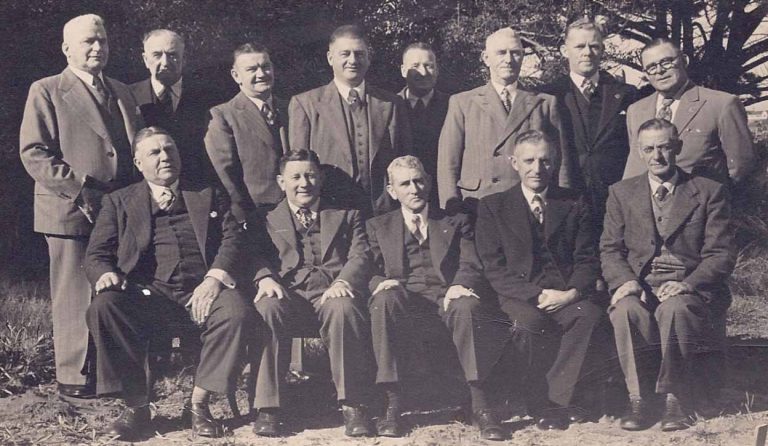Lewis George Pimblett - inventor of Harbord + Mona Vale: Toymaker of 'pim's toys' + first speaking robot maker of 1952
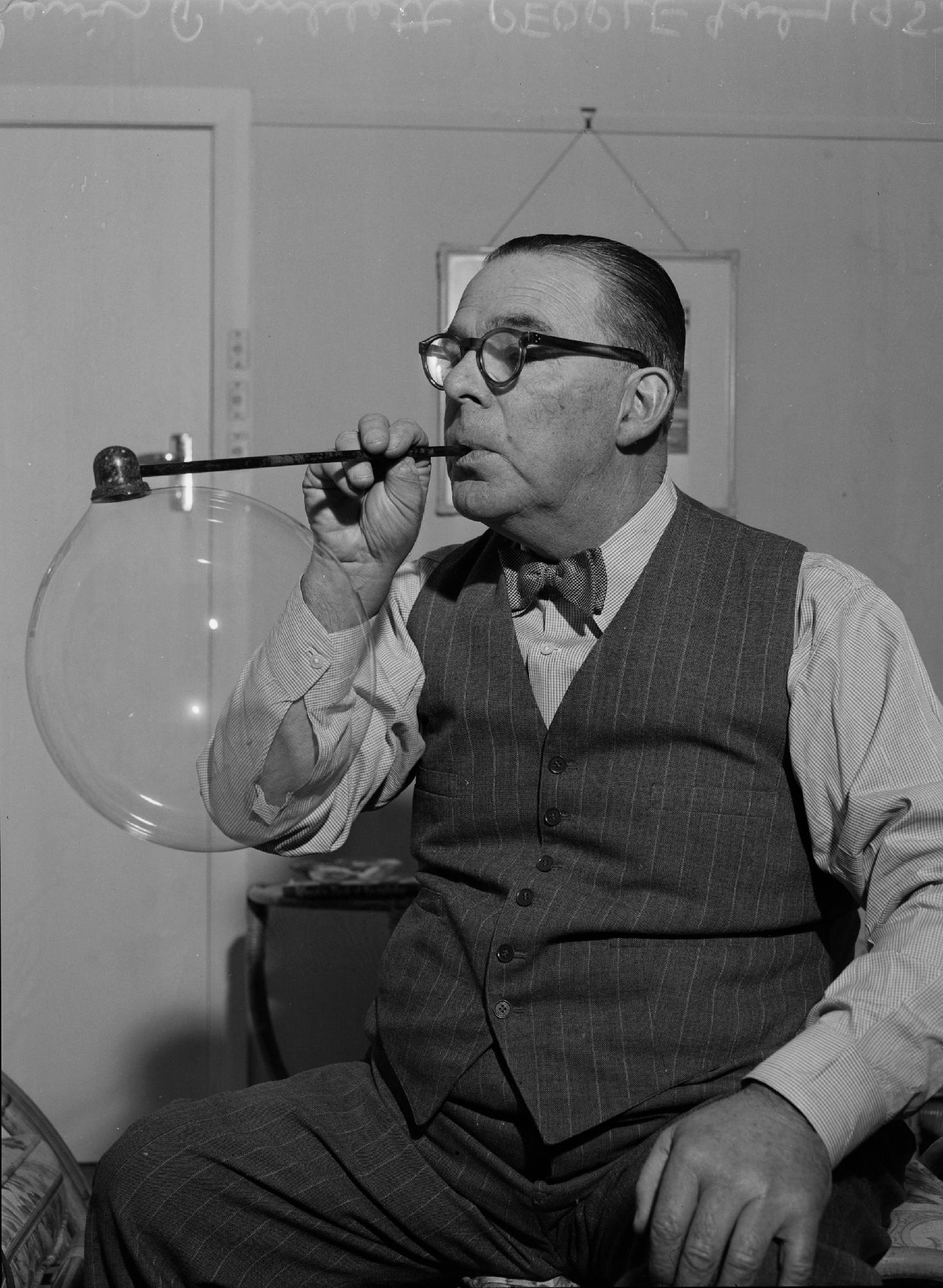
Although this history insight has been penned for youngsters who like building things over the school holidays, older readers will certainly remember some of the inventions of Lewis Pimblett or 'Pims toys'.
Lewis George Pimblett was born November 13th 1892, in Beaufort, Victoria, one of at least six surviving children, and the youngest born child of William Chapman Pimblett and Mary Hill (nee Roberts – mother’s name Trembath), who had married in 1876.
Beaufort is located on the Western Highway midway between Ararat and Ballarat. Thomas Mitchell passed through the district on his expedition of 1836. Early settlers in the area were the Kirkland Brothers and a Mr. Hamilton; the latter took up Trawalla Station in 1838. The station was taken over by Adolphus Goldsmith in 1841 - Lake Goldsmith was named after him.
Gold was discovered in 1852, with another gold rush from 1854 at nearby Fiery Creek. The Fiery Creek diggings supported four townships, Beaufort, Yam Holes Creek, View Point and Southern Cross, during the 1850s. The population on the fields reportedly reached approximately 100,000 people at its height in the late 1850s and produced 450,000 ounces of gold over a two-year period, 1855–1856.
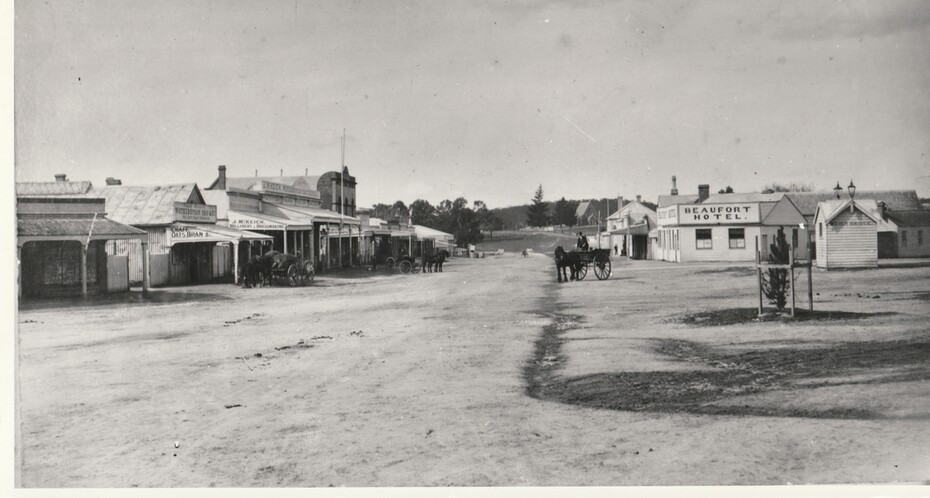
Beaufort Streetscape, circa 1870. From the collection of Beaufort Historical Society Victorian Collections. Retrieved from https://victoriancollections.net.au/items/623a77556851323cf265e22c
William Pimblett was a coachmaker, and the eldest son of at least 11 children of William Chapman Pimblett and Jane Purcell. William Chapman Pimblett senior was born 8 Feb 1824 in Ashton in Makerfield, Lancashire, England, United Kingdom. Jane Tuddenham (formerly Purcell) was born 1832 in Lismore, County Waterford, Ireland.
Both his grandparents died in the area – all having come out to Australia.
Lewis worked with his father in the coach making business from an early age. Although his mother and father died while he was still very young he stayed in the area working with the brother who took over the business and learned a trade in steel working, Albert William Pimblett, born 1880.
BEAUFORT.
Saturday. OBITUARY.
(From Our Correspondent.)
The death of Mrs W. C. Pimblett, an old and respected resident of Beaufort, occurred on Wednesday evening after an illness of about 12 months’ duration, the cause of death being anaemia.
Deceased, whose age was 46 years, was born at Fryer’s Creek in 1855, and was married, in 1876. For many years she carried on a dressmaking business at Beaufort. Deceased, who was highly esteemed for her many good qualities, leaves a husband and 6 children to mourn their loss, and much sympathy is felt for them in their bereavement. Her remains were interred in the Beaufort Cemetery this afternoon, the funeral being largely attended. The coffin, which was borne to the grave from the hearse by Messrs M. and J. Pimblett, W. C. Pedder, and A. H. Sands, was covered with beautiful floral tributes of sympathy, a very handsome harp of immortelles, being sent by the Beaufort Brass Band, of which deceased’s husband is a member. The obsequies at the grave were conducted by the Rev. W. J. Bottoms. Mr A. H. Sands, undertaker, Beaufort, carried out the mortuary arrangements. BEAUFORT. (1902, May 19 - Monday). The Ballarat Star (Vic. : 1865 - 1924), p. 2. Retrieved from http://nla.gov.au/nla.news-article207628477
PIMBLETT.— On the 14th May, at the residence of her husband, the beloved wife of W. C. Pimblett, of Beaufort, aged 46 years. Family Notices (1902, May 16). The Age (Melbourne, Vic. : 1854 - 1954), p. 1. Retrieved from http://nla.gov.au/nla.news-article199400682
OBITUARY
The funeral of Mr W. C. Pimblett took place yesterday afternoon, to the Beaufort Cemetery, in the presence of a large number of sympathising friends. The coffin, which was covered with beautiful floral tributes of sympathy, was borne to the grave by Messrs W. C. and W. A. Pedder, D. Tuddenhum, and E. J. Loft; whilst four members of the Orange Lodge, viz. Brs G. Topper, R.Wardard, R. Boyle, and J. B. Cochran, acted as pallbearers. The Rev. J T. Kearns conducted service at the grave, and Br. Coltman, as chaplain, read the Orange funeral service. OBITUARY (1908, October 3). The Ballarat Star (Vic. : 1865 - 1924), p. 1. Retrieved from http://nla.gov.au/nla.news-article218561536
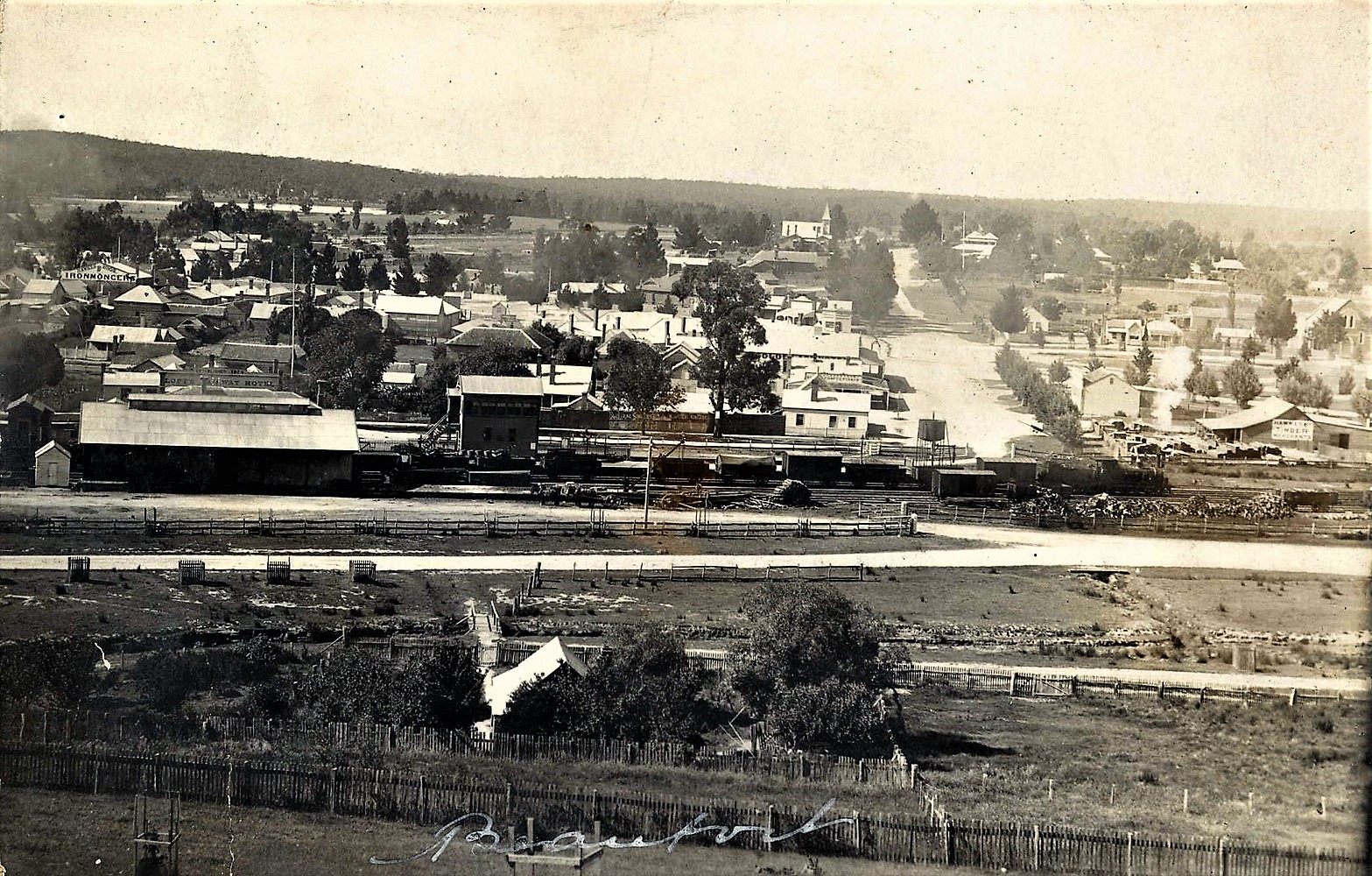
Beaufort, circa. 1912- Shows view over town of Beaufort, railway station and goods yards in middle distance – ironmongers can be seen to left of photo. Postcard, Item: FL16188314, courtesy State Library of Victoria.
Lewis was soon venturing further afield than Beaufort and by 1911 was in NSW:
The Yerong Creek Sports Club's programme for the meeting to be held on Saturday next, is advertised on another page. There are numerous events, which should prove attractive to spectators and competitors alike, the latter having the opportunity to gain prizes to the value of about £40. Entries close to-day with the secretary, Mr. L. G. Pimblett. THE WEATHER. (1911, March 21). Daily Advertiser (Wagga Wagga, NSW : 1911 - 1954), p. 2. Retrieved from http://nla.gov.au/nla.news-article143082527
Yerong Creek is a town in the Riverina area of southern New South Wales, Australia. It is about 46 kilometres south-west of Wagga Wagga - At the 2016 census, Yerong Creek had a population of 173. Yerong Creek station is serviced twice daily by NSW TrainLink XPT trains which travel along the Main Southern Railway line between Sydney and Melbourne (there is no stop listed in timetables for Yerong Creek; the nearest stations are The Rock to the north and Henty to the south). The town is home to a small population and was the original home of the vintage rally. Whilst Yerong Creek is predominantly a mixed farming and grazing area, it holds a claim in Australian history when in 1993 the XPT established the Australian Rail Speed Record of 193 kilometres per hour (120 mph) between a nearby area known as Table Top and the township
He married Mary Irene Turner in 1914, in Petersham, New South Wales and their first daughter of three was born the same year. Irene was the daughter of Alexander and Margaret Turner with her birth, in 1889, registered at Goulburn.
He then worked as a Striker from August 27th 1915 at Everleigh Railway workshop in the area of Locomotives and lived in Campsie, New South Wales, his occupation is listed as iron worker. A striker was one of the 'gang' who laid tracks.
The Eveleigh Railway Workshops is a heritage-listed former New South Wales Government Railways yards and railway workshops and now venue hire, public housing and technology park located at Great Southern and Western railway, Redfern, City of Sydney, New South Wales, Australia. It was designed by George Cowdery and built from 1882 to 1897 by George Fishburn. It is also known as Eveleigh Railway Yards, South Eveleigh Precinct; North Eveleigh; Macdonaldtown Gasworks; Macdonaldtown Triangle and also by the name of its current occupants, Carriageworks. The property is owned by the Transport Asset Holding Entity, an agency of the Government of New South Wales. It was added to the New South Wales State Heritage Register on 2 April 1999. The workshops are considered to have world heritage significance by curators of the Smithsonian Institution.
The Locomotive Workshops were the brick workshop building located in South Eveleigh operated from 1884 to 1986 and overhauled, repaired, modified and built new locomotives for New South Wales Government Railways. Classes of successful locomotives from the small C30 Class through the C38 Class and D58 Classes and assembly of the largest AD60 Class locomotives.
Eveleigh Railway Workshops consisted 15 Bays featuring:
- Bays 1 and 2 – Blacksmith's Shop, 1500T Davy Press, 40cwt double-arch steam drop hammer, a 20cwt heavy steam hammer plus numerous small hammers.
- Bays 3, 4 and 4A – Boilermaker's Shop, with Bay 3 featuring the Heat Treatment Room
- Bay 5 – Canteen and Fitting Shop, 1st year apprentice Fitters (Boystown)
- Bay 6 – Millwright's Shop
- Bays 7 and 8 – Fitting Shop
- Bay 9 – Axles and Wheels
- Bays 10, 11 and 12 – Machine Shop
- Bays 13 and 14 – Tool and Instrument Room
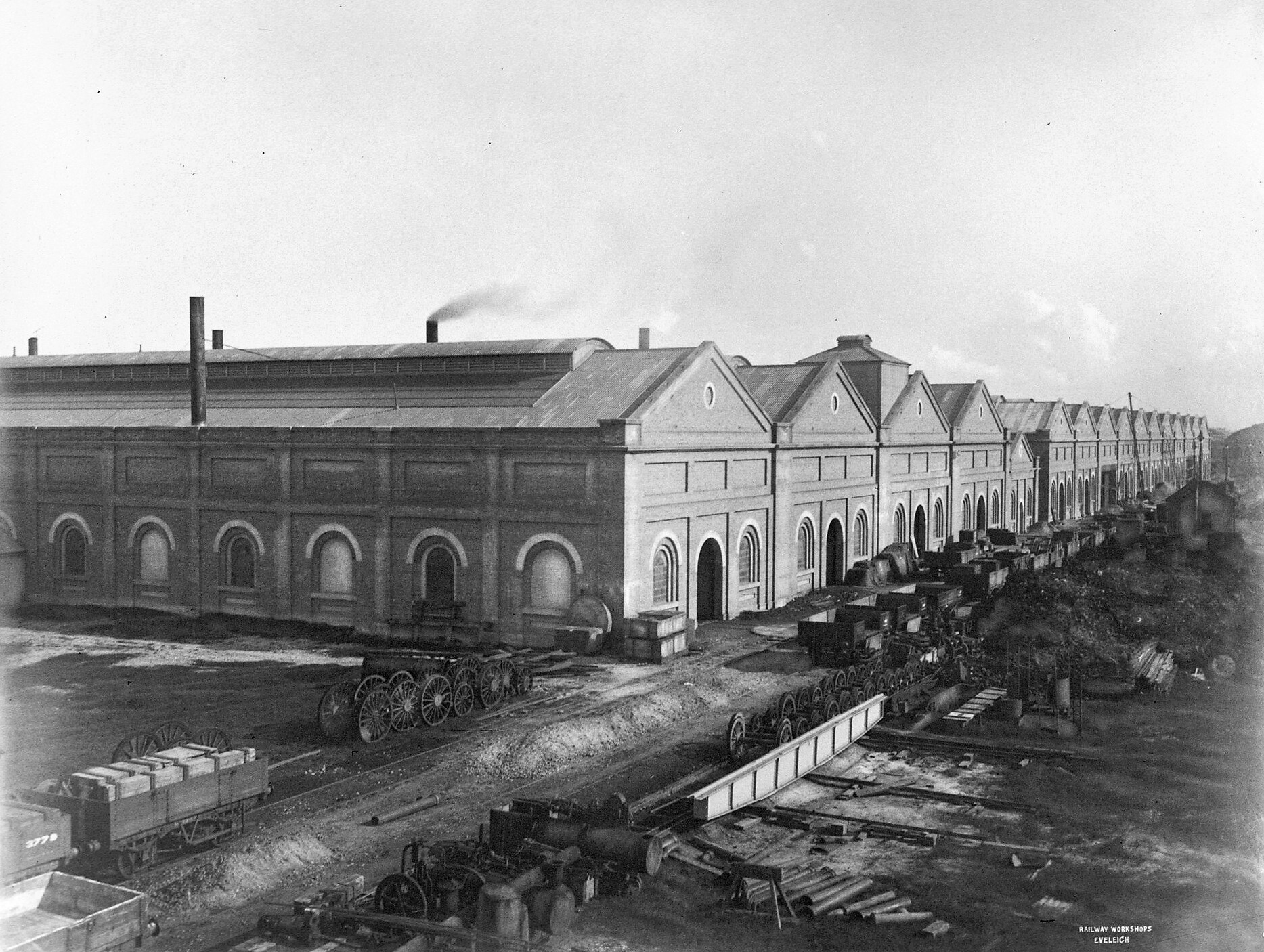
Eveleigh railway workshops, Contents Date Range 01-01-1900 to 31-01-1900, Government Printing Office 1 - 08116 – Item: FL3490699, courtesy NSW Record and Archives
On July 19th 1916 he enlisted to serve in the AIF, aged 22 and a half, Service Number - 6087.
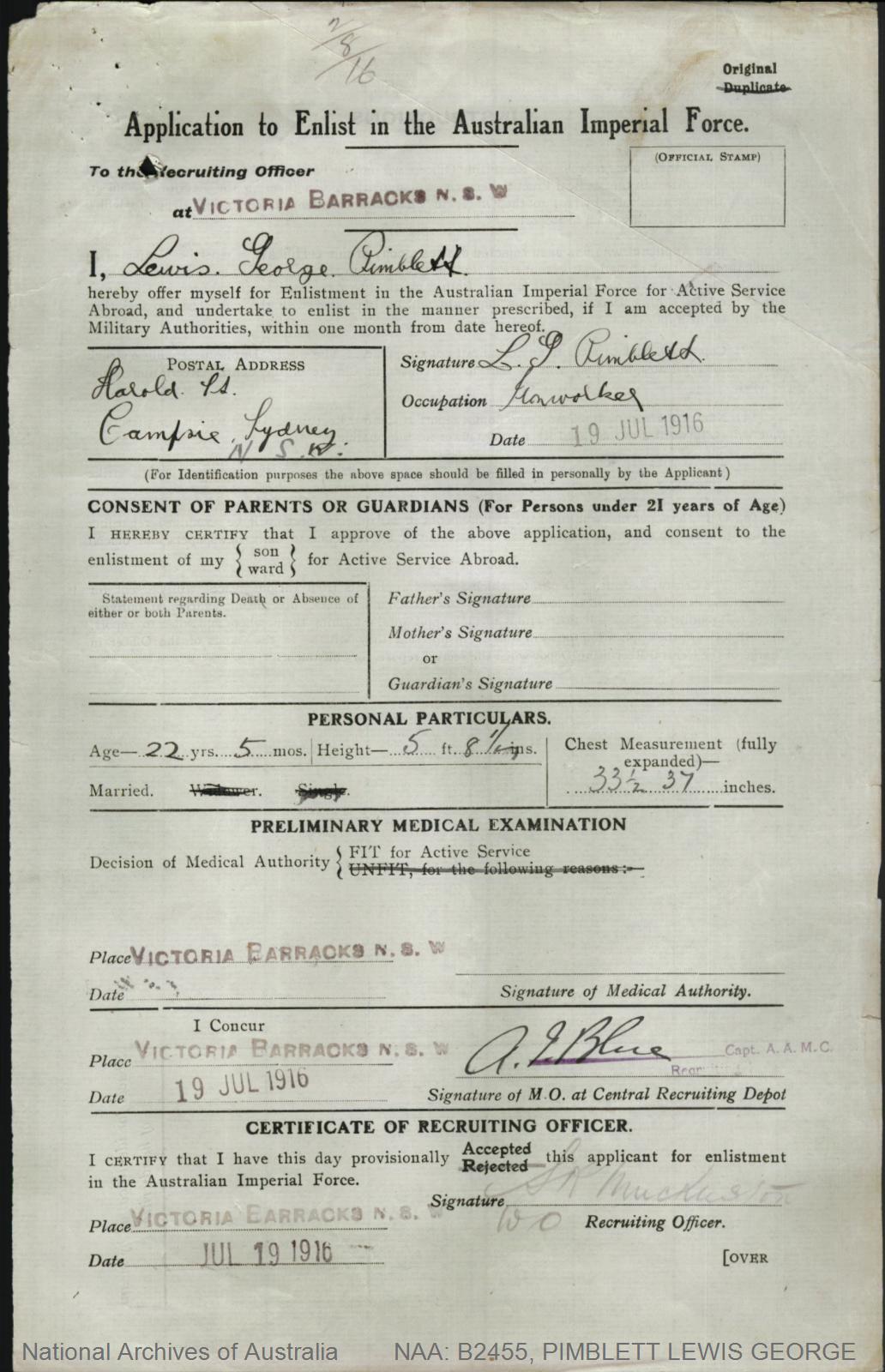
He was sent via the 'Afric', embarking in Sydney on November 3rd 1916, as part of the 21st Battalion, 17th Reinforcements, and disembarked at Plymouth on January 9th, 1917.
SS Afric was a steamship built for White Star Line by Harland and Wolff shipyards. She was of the Jubilee class, had a reported gross register tonnage of 11,948, and had a port of registry of Liverpool, England. Afric was launched on November 16, 1898, and was involved in shipping between Liverpool and Australia.
Afric was the first of five Jubilee-class ships built by White Star Line for their new service to Australia, the others were Medic, Persic, Runic and Suevic. Afric was a single-funnel liner with capacity for 320 third class passengers on three decks, she also had substantial cargo capacity with seven cargo holds, most of them refrigerated for the transport of Australian meat.
Following the outbreak of the First World War in 1914, SS. Afric was requisitioned by the Australian government in October 1914 for use as a troopship and was given the designation HMAT (Hired Military Australian Transport) A19. In April/May 1915 she was refitted at Sydney to carry 549 troops and 500 horses. She completed six troopship voyages up to November 1916, however on February 12th 1917 she was sunk in the English Channel after being torpedoed by the German submarine SM UC-66, whilst sailing outbound between Liverpool and Plymouth, 12 miles (19 km) south south-west of the Eddystone Lighthouse, there were 145 survivors, but 22 people lost their lives.
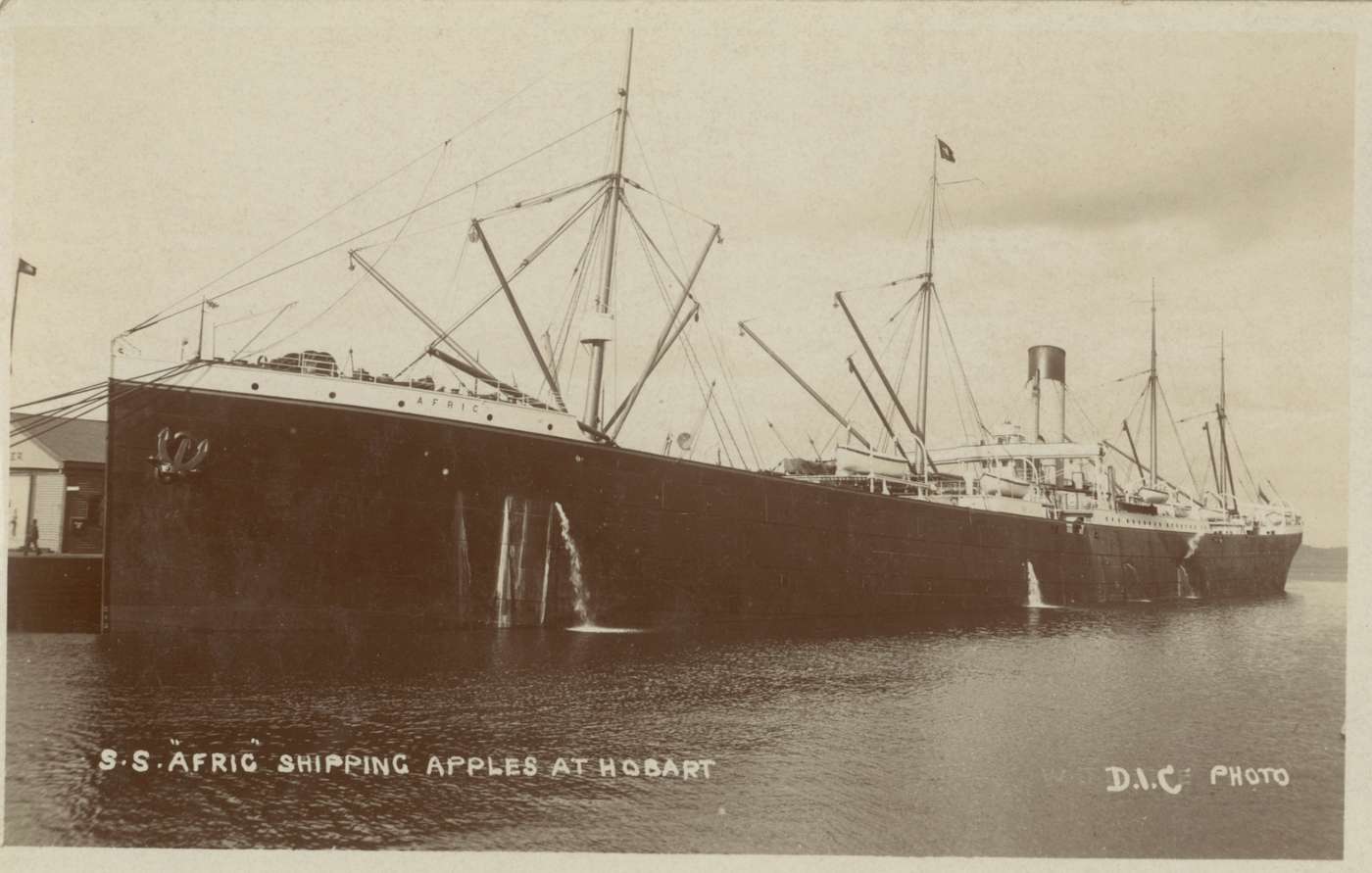
White Star Liner Afric at Hobart, photo courtesy State Library of New South Wales
He became part of the 6th Reinforcements Training Battalion at Lark Hill, Wiltshire England two days later.
He was sent into France on July 30th 1917, becoming part of the 22nd Battalion's reinforcements.
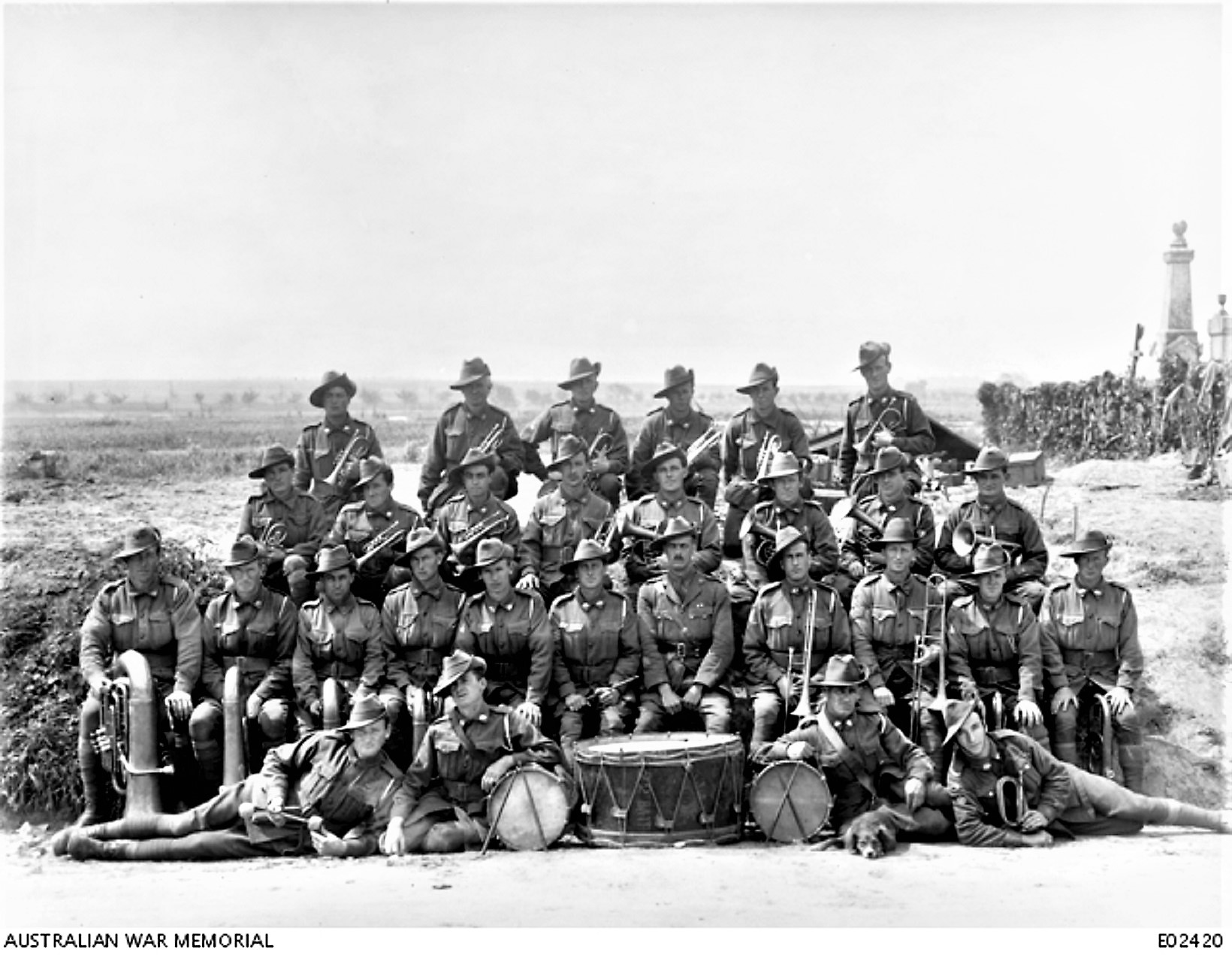
Group portrait of members of the band of the 22nd Battalion, and their instruments, with their dog mascot. Back row, left to right: 6447 Private (Pte) J. Turner; 6032 Pte J. Durkin; 4358 Pte W. Baker; 1937 Pte H. Mitchell; 5893A Pte H. Riddell; 5856A Pte P. Greenburg. Third row: 4 Pte D. Smith; 6860 Pte F. McIntosh; 5167A Pte T. Miller; 3954 Pte B. Tucker; 6087A Pte L. Pimblett; 4067 Pte E. Ayres; 1064 Pte W. Small; 1749 Pte C. Westmore. Second row: 5672 Pte J. Smeetman; 5396 Pte C. McLennan; 5877 Pte P. Bell; 5800 Lance Corporal (LCpl) J. Bulch; 5893 Pte F. King; 1677 Sergeant H. Connell; Lieutenant Colonel Wiltshire DSO MC; 75 LCpl J. Brown; 77 Company Sergeant Major J. Cugley MSM; 5914 Pte R. Stewart; 4402 Pte R. Cox. Front row (lying on ground): 919 Pte J. Strain MM; 6078A Pte G. Porter; 4125 Pte I. Harris; 1181 J. Cummings, Bugler.
The 22nd Battalion AIF was formed on March 26th 1915 at Broadmeadows Camp in Victoria. The battalion became part of the 6th Brigade of the 2nd Division. Most of the battalion embarked for Egypt on May 8th 1915. The battalion deployed to Gallipoli in the first week of September 1915 allowing elements of the 2nd Brigade to be rested from their positions in the front line at ANZAC. The battalion served on the peninsula until the final evacuation in December 1915, and were then withdrawn to Egypt and brought back to strength with reinforcements.
While most of the battalion was serving on Gallipoli the transport drivers, along with the other drivers from the 6th Brigade, were sent to the Salonika front to support the Serbs. They did not rejoin the battalion until after the evacuation of ANZAC.
In March 1916, the battalion embarked for France and experienced their first service on the Western Front in reserve breastwork trenches near Fleurbaix at the end of the first week of April 1916. The battalion's first major action was at Pozieres, part of the massive British offensive on the Somme. In September/October they were moved to the Ypres sector then back to the Somme for the Winter. The battalion spent most of 1917 bogged in bloody trench warfare from Bullecourt to Broodseinde in Flanders. In 1918 the battalion returned to the Somme valley. After helping to stop the German spring offensive in March and April, the 6th Brigade participated in the period of peaceful penetration of the enemy lines. It was in mid-May that Sergeant William 'Rusty' Ruthven earned the 22nd Battalion's only Victoria Cross. In the last days of August and September the battalion helped capture Mont St Quentin.
The 22nd Battalion took part in the last action fought by the AIF on the Western Front, the battle of Montbrehain, in October 1918.
At 11 am on 11 November 1918 the guns on the Western Front fell silent. The November Armistice was followed by the Peace Treaty of Versailles signed on June 28th 1919. The last elements of the battalion began their journey home from the Western Front in May 1919 to return to Australia for demobilisation and discharge. - AWM notes
The 22nd Battalion also produced their own magazine, 'The Twenty Second's Echo', while on the front and caricature sketches drawn by Lewis, or 'Lou' and 'Pim' as he was known by those he served with, were part of that - one example is:
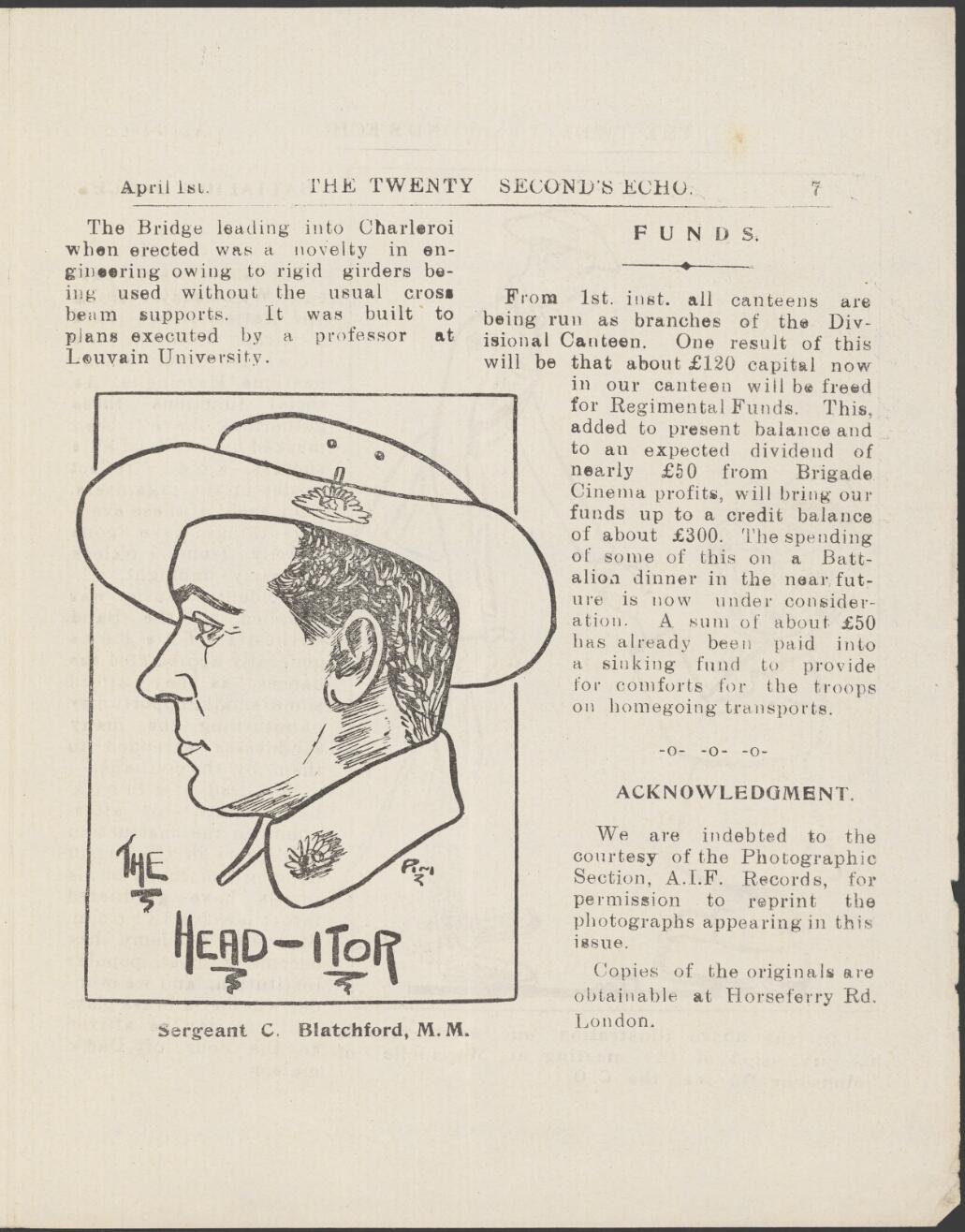
Australia. Army. Battalion, 22nd. (1918-1919). NEWS SUMMARISED, The Twenty-Second's echo : random shots from the red and purple diamonds Retrieved from http://nla.gov.au/nla.obj-64202970
"THE TWENTY SECOND'S ECHO."
Under this novel 'title we have received a copy of a small newspaper printed and published in the battle zone by the 22nd Battalion press, from which we take the following extracts:
The division has -been inspected by the Commonwealth Prime Minister, Mr. W. M. Hughes, and Minister for 'the Navy, Mr. Joseph Cook. Mr. Hughes was attended by Generals Birdwood and Monash. The parade was conducted by Lt.. Col. A. R. Wiltshire, D.S.O., I.C. s (late of Euroa.) After the inspection, the Prime Minister, addressing the parade, said that he conveyed the thanks of the Australian nation for their splendid deeds. He referred to the scheme now being passed to provide for any soldier who was maimed or disabled, so that they would never want. The Repatriation scheme would provide work for all returned men. Mr. Hughes advised the men to have no fear of returning, and promised that they would be well looked after. With regard -to the future, there were more battles to face, but we could look forward confidently to repeating the deeds we had already performed.
Mr. Cook said that the war had' brought them an entirely different outlook. After all these years of fighting in Parliament against Mr Hughes, they had joined hands to assist the lads who had come from Australia to fight the Hun. Since leaving Australia he had travelled far and been in many countries, in every one of which the reputation of Australia stood high. Now that our American comrades were here, we looked hopefully forward to an early finish.
The people of Australia realised the part the troops were playing over here, and practically everybody was working for the comfort of the troops in the trenches. The official photographer to the A.I.F., Lt..G. A . Wilkins, was present securing a bioscope picture. The films will probably appear in due course in Australia.
The celebrated Australian artist, Lt. J. Longstaff, (late of Shepparton) was also present. It is seldom indeed that Australian troops in France have an opportunity of hearing a speech made by statesmen from their nation land, and the event will long be remembered by those who were present. –
"What's the delay?" asked an officer, striking a traffic block. "French' for milk, you stupid --replied an Aussie mule-driver.
The ',Amurricans" fittingly celebrated the "Glorious Fourth.' The happenings of that' day should further cement the 'cordial feeling that exists between the Aussies and the Guys.
Our R. M.Q.S , made a startling discovery a day or two ago. . no less than two pieces of pork were found in one tin of pork and beans. Our food supplies must be inexhaustible when such prodigality can be indulged in. Berlin and Vienna papers please copy.
Though: Sgt Kohn was unfortunate to lose a bicycle I think his recovery of it was miraculous. Don't you?
FOR MOTHERS ONLY. Don't worry 'too 'much over that official notification, that your son is suffering from "gunshot. wounds." It sounds bad and suggests a combination of double barrelled guns and barbed-wire fences. Actually it covers almost every trivial "Blighty," and by the time you get the notice, your "wounded hero" is probably doing Piccadilly and West-End of London. When you see him again, ask him about the "awful" time he had in hospital. If he has not been permanently disabled, and replies truthfully, he will assure you that the time he spent in hospital was the best time he spent - apart from leave - since he left Australia. Everybody was kind to him; the nurses, untiring in their devotion. And just one other thing for your comfort. Every wounded Aussie doesn't marry his nurse, though we are bound to admit they are awfully nice. "THE TWENTY SECOND'S ECHO." (1918, September 13). Euroa Advertiser (Vic. : 1884 - 1920), p. 3. Retrieved from http://nla.gov.au/nla.news-article70379519
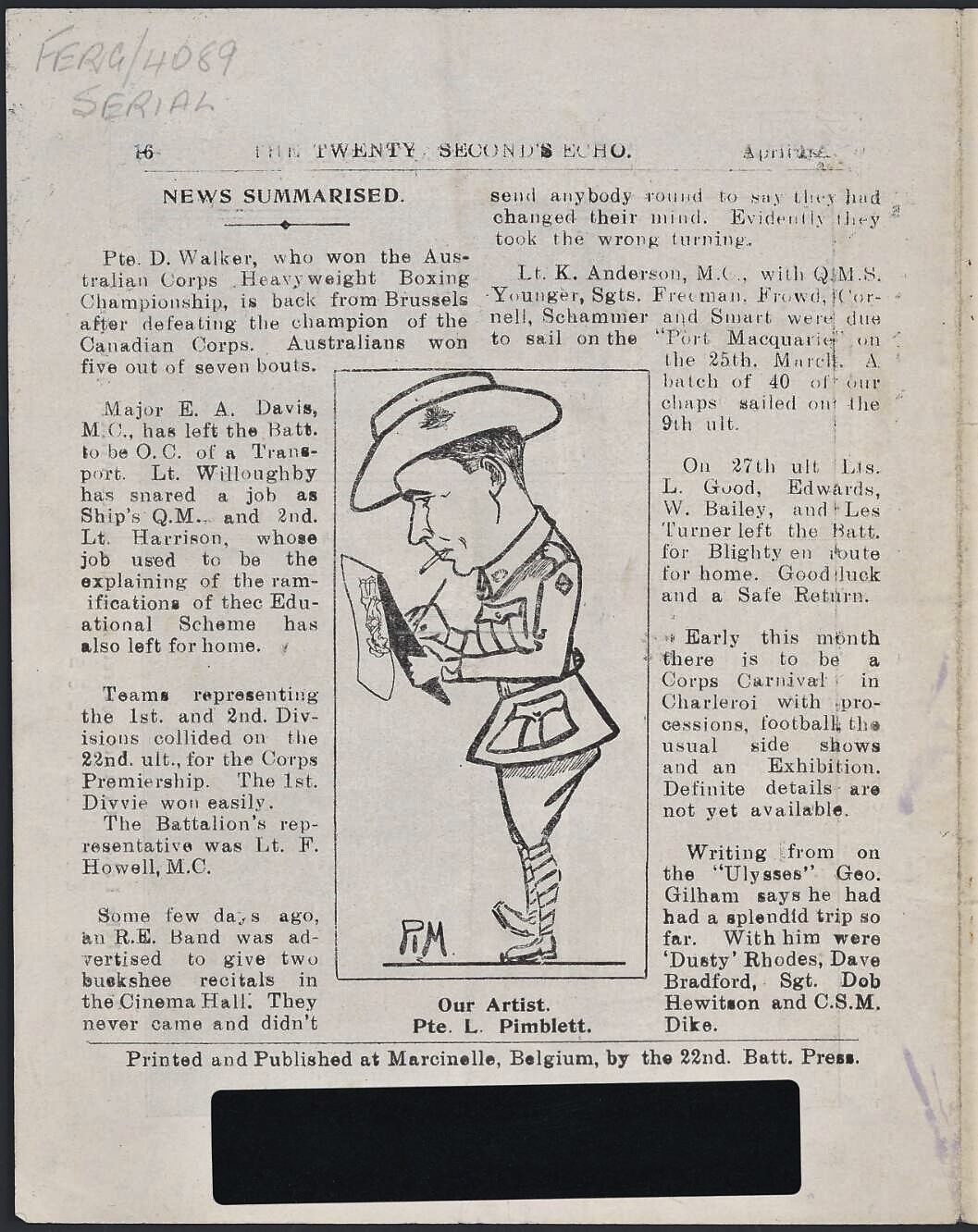
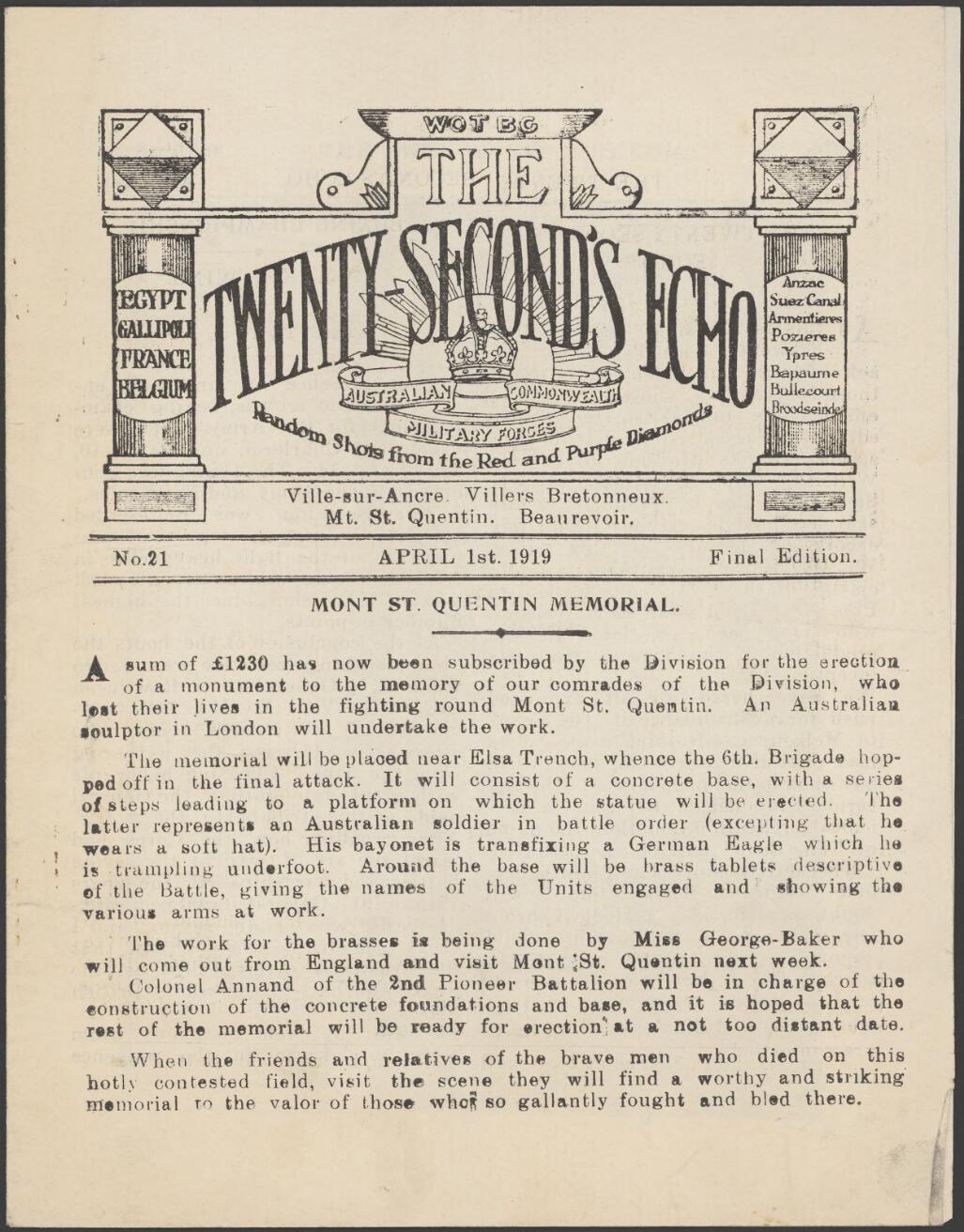
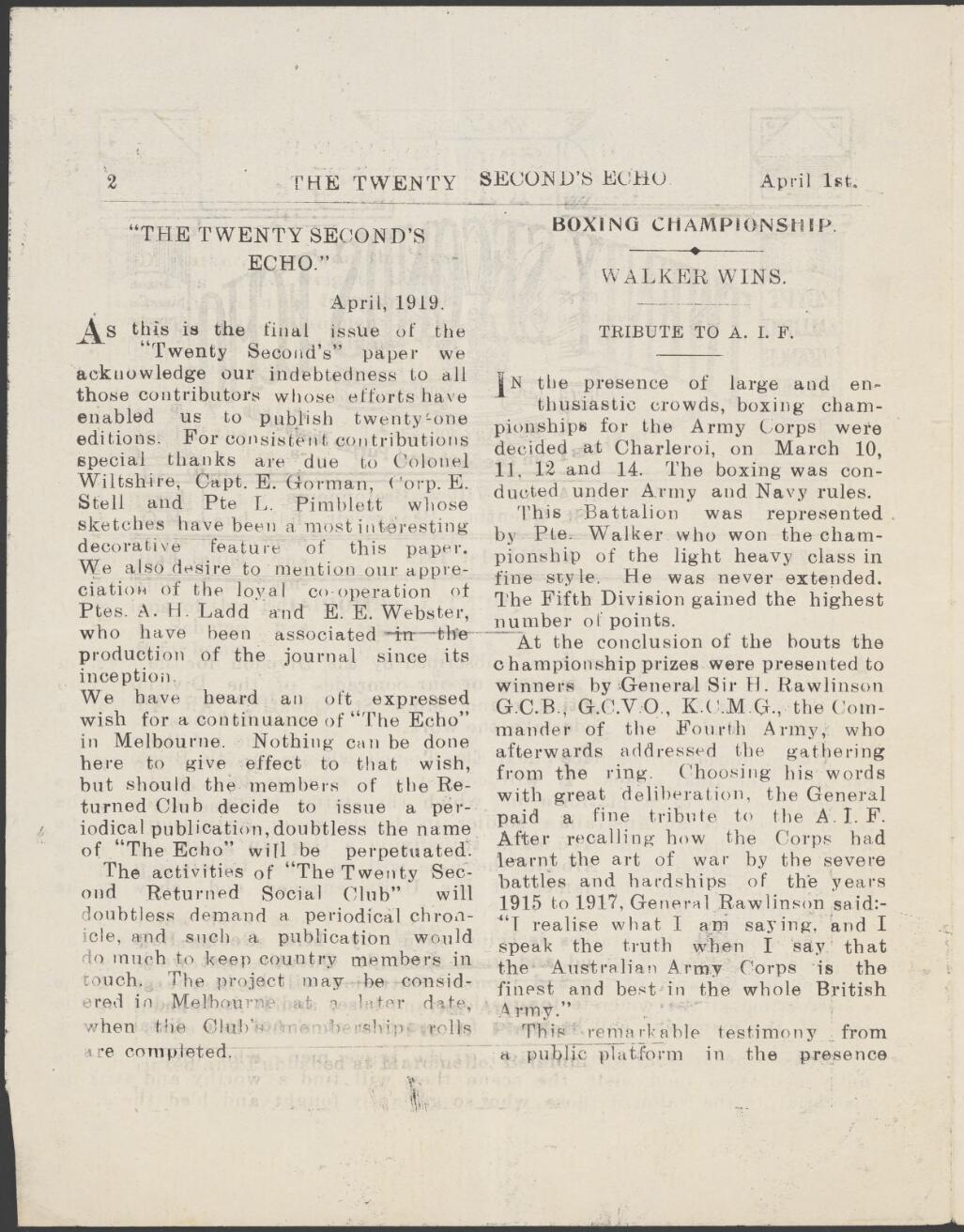
Final Issue: April 1st 1919: Australia. Army. Battalion, 22nd. (1918-1919). The Twenty-Second's echo : random shots from the red and purple diamonds Retrieved from http://nla.gov.au/nla.obj-6375265
One of his older brothers served too:
WOUNDED IN ACTION. Pte. H. H. PIMBLETT, Hobart, second occasion (severely). WOUNDED IN ACTION. (1917, November 30). Examiner (Launceston, Tas. : 1900 - 1954), p. 6 (DAILY). Retrieved from http://nla.gov.au/nla.news-article50955893
PIMBLETT, Harold Henry ; Private · 19th Infantry Battalion · born Beaufort, Vic., 1886 · North Sydney, North Sydney - First World War Embarkation Roll Harold Henry Pimblett ; Service Number 6127 · Private · 19 Infantry Battalion - 14 to 17 Reinforcements (August-October 1916)
PRIVATE H. H. PIMBLETT
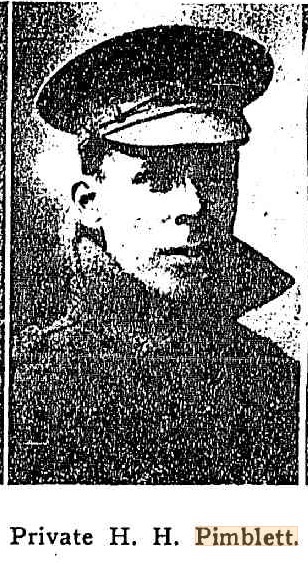
Mrs Geo. Nothnagel, of Beaufort, has received a message intimating that her brother, Pte H. H. Pimblett, has been wounded in France. The wounded soldier is a Beaufort native, but enlisted in Sydney, where his wife and family reside. He has a brother (Pte Lewis Pimblett) on service abroad. PRIVATE H. H. PIMBLETT. (1917, May 24). The Ballarat Courier (Vic. : 1869 - 1885; 1914 - 1918), p. 4 (DAILY.). Retrieved from http://nla.gov.au/nla.news-article74571483
Henry survived, came home, and moved to Hobart, where he became the Government Printer until retirement:
GOVERNMENT PRINTER
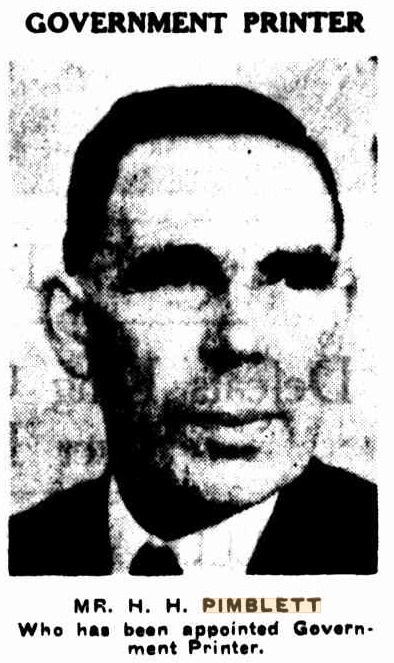
MR. H. H. PIMBLETT Who has been appointed Government Printer. GOVERNMENT PRINTER (1938, June 13). The Mercury (Hobart, Tas. : 1860 - 1954), p. 9. Retrieved from http://nla.gov.au/nla.news-article25484549
Private Lewis Pimblett left England via the 'Chemistry' on July 7th 1919 and was discharged on October 23rd, 1919. Alike many who served in this horrific conflict he could not easily settle back into his old life. He resigned his position in the NSW Railways and embarked on what would become a lifelong series of businesses he started himself or in conjunction with others.
Index Name: Register of Firms Index
Name of Firm: SALVANA SIGN SERVICE
Nature of Business: Signwriters decorators picture frames & paint & oil colour merchants
Place of Business: 97 Parramatta Road Annandale
Person Carrying on Business: SALVANA, John; PIMBLETT, Lewis George; HOMER, Robert
Date of Registration: 21 Sep 1920
The above didn't last too long with 'Pim' as part of it as he went back to an obviously favourite place - Deniliquin where his lifelong fascination with anything new in inventions could be exercised:
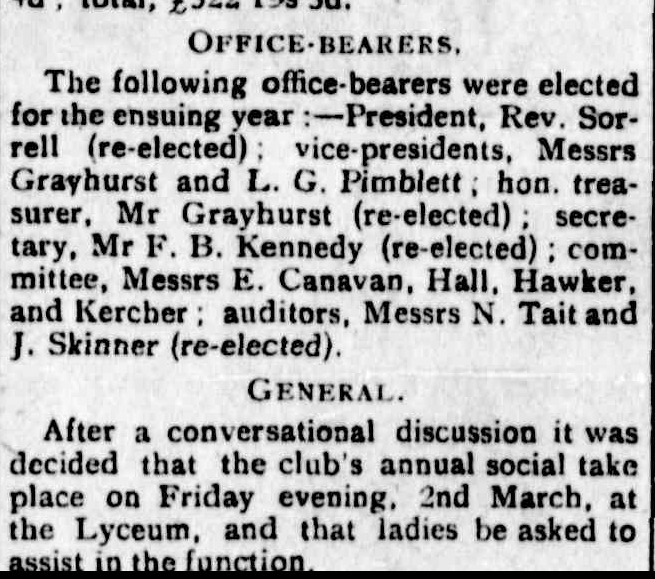
All Diggers' Entertainment. (1921, September 23). The Independent (Deniliquin, NSW : 1901 - 1946), p. 2. Retrieved from http://nla.gov.au/nla.news-article101558174
Deniliquin is a town in the Riverina region of New South Wales, Australia, close to the border with Victoria. It is the largest town in the Edward River Council local government area, formed in 2016 from the merger of the Deniliquin Council with the surrounding Conargo Shire. Deniliquin is located at the intersection of the Riverina and Cobb Highway approximately 725 kilometres (450 mi) south west of the state capital, Sydney and 285 kilometres (177 mi) due north of Melbourne. The town is divided in two parts by the Edward River, an anabranch of the Murray River, with the main business district located on the south bank. Currently and even then, the town services a productive agricultural district with prominent wool and timber industries, and later, rice. At the 2016 census, the urban population of Deniliquin was 7,862.
By 1923 Lewis Pimblett has a film theatre at Deniliquin:
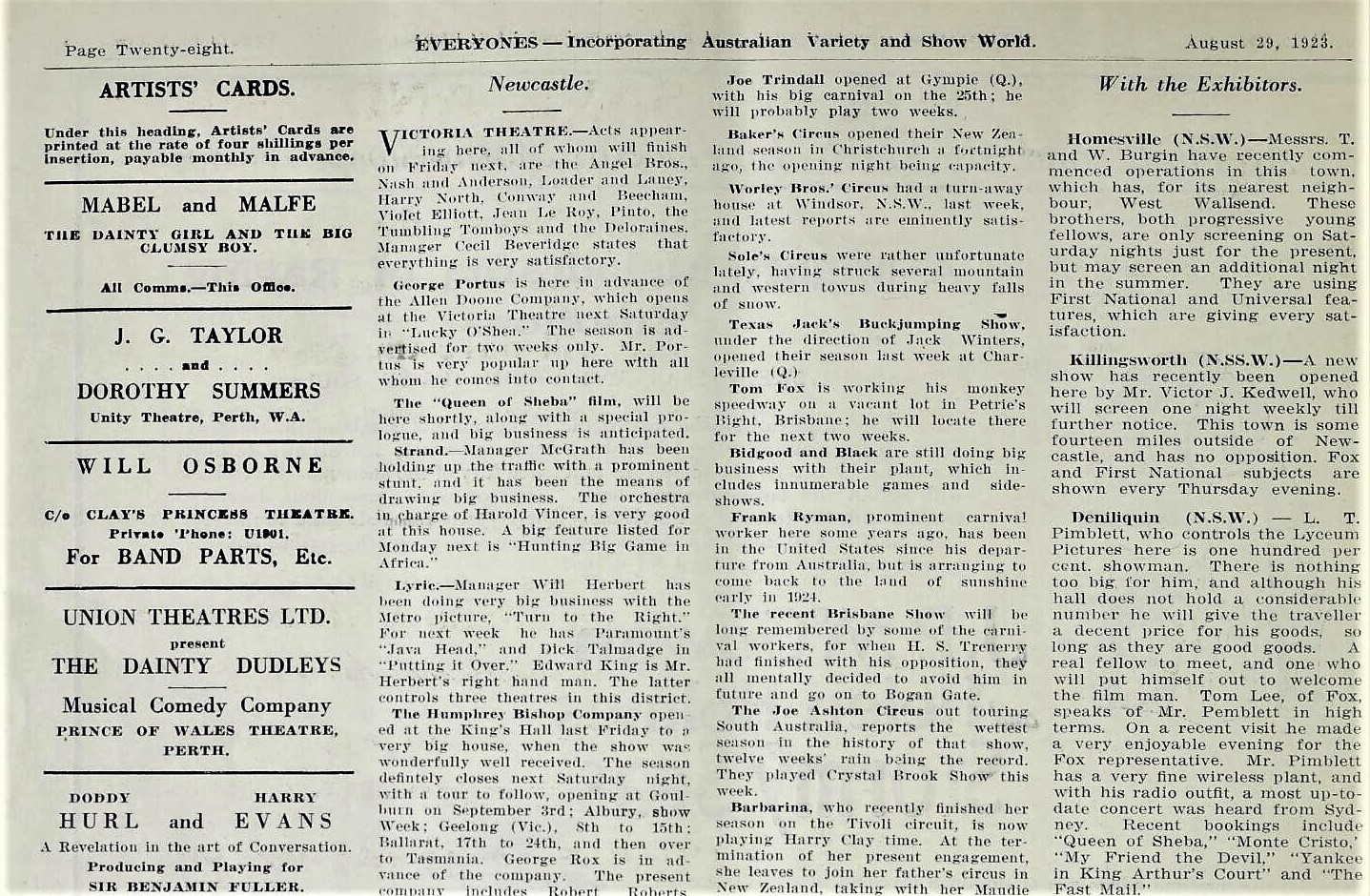
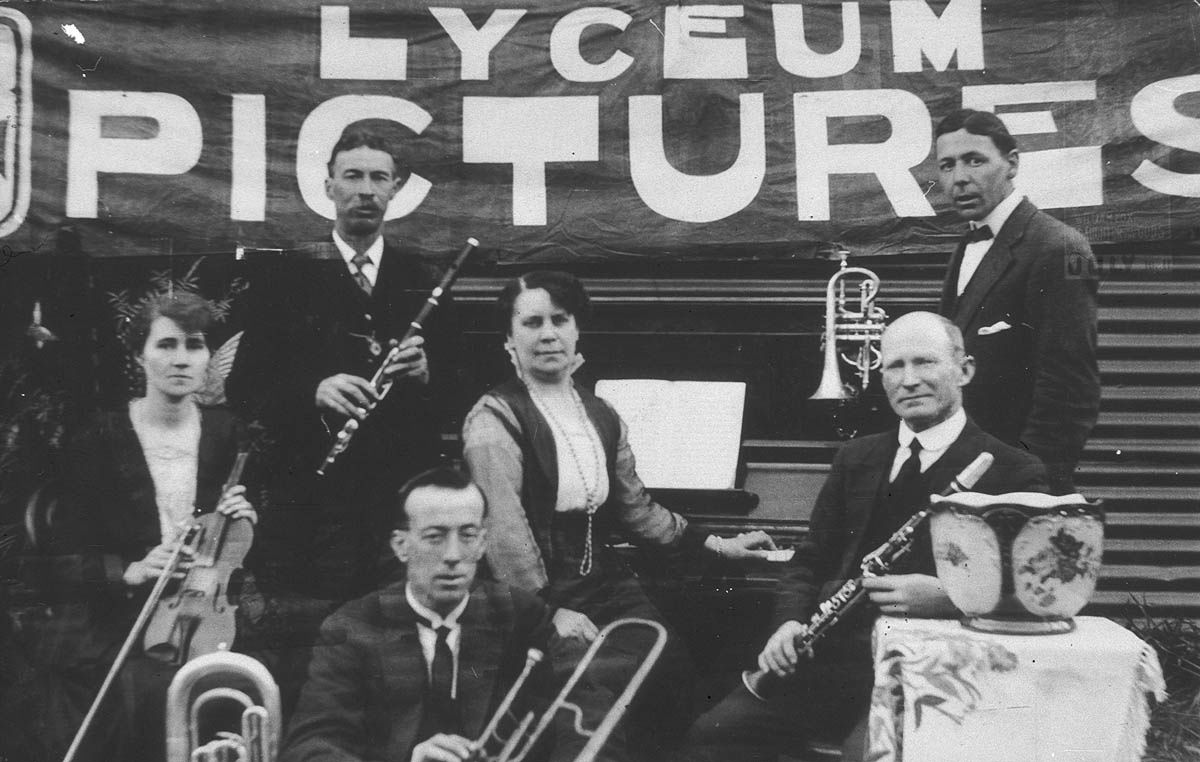
Orchestra at the Lyceum Picture Theatre - Deniliquin, NSW, courtesy State Library of NSW
While at Deniliquin and here commenced his foray into radio - which would prove great knowledge for a future venture of the talking robot built when he lived at Mona Vale:
Returned Soldiers and Sailors.
ANNUAL MEETING.
The annual meeting of the Deniliquin branch of the Returned Soldiers and Sailors' Imperial League of Australia was held at the club rooms, End street, on Monday evening last. Rev. J. H. Sorrell (president) occupied the chair, and there were also present Rev. Canon E. Jellicoe Rogers, Messrs L. G. Pimblett, E. Canavan, F. Grayhurst, R. Hall, A. J. Hawker, G. McCann, J. Kercher, and F. B. Kennedy, (secretary).
The president, in opening the meeting, referred to the work of the club during the past year. He said that from the Patriotic League, which had been controlled by the ladies of the town, they had received £161 for the creation of a district soldiers' relief fund, and from the local branch of the Red Cross Society £50 — a total of £211. Mrs H. L. Wilkinson had prior to her departure from Deniliquin donated £10 10s for the returned men, to be applied in whatever way the committee thought best. He was pleased to say that although the club was established chiefly for assisting returned soldiers and sailors, only one application for relief had been received during the year. BALANCE-SHEET. The hon. treasurer (Mr F. Grayhurst) read the balance-sheet, as follows : — Receipts. — Balance from last year, £163 2s 4d ; amusements, £16 8s 9d ; donations, £97 17s ; sundry receipts, £23 1s 2d ; members' subscriptions, £22 10s ; total, £322 19s 3d. Expenditure. — Salaries and wages, £22 10s ; printing, advertising, and stationery, £15 7s 3d ; papers, £9 19s 10d ; donations, £4 4s; fuel and light, £14 6s 3d ; repairs, 7s 6d ; furniture, £82 10s; sundries, £45 7s 1d; balance as per pass book, £128 7s 4d ; ;total, £322 19s 3d. OFFICE-BEARERS. The following office-bearers were elected for the ensuing year : — President, Rev. Sorrell (re-elected) ; vice-presidents, Messrs Grayhurst and L. G. Pimblett ; hon. treasurer, Mr Grayhurst (re-elected); secretary, Mr F. B. Kennedy (re-elected) ; committee, Messrs E. Canavan, Hall, Hawker and Kercher ; auditors, Messrs N. Tait and J. Skinner (re-elected). GENERAL. After a conversational discussion it was decided that the club's annual social take place on Friday evening, 2nd March, at the Lyceum, and that ladies be asked to assist in the function. Messrs Pimblett, Grayhurst, and Hall were appointed a sub-committee to attend to the musical portion of the evening, and the general carrying out of the social was left in the hands of the president and secretary. An application by Mr J. Burchfield for half cost of the dividing fence between his property and the club's was received. After minor business, had been dealt with, the meeting terminated. Returned Soldiers and Sailors. (1923, February 16). The Independent (Deniliquin, NSW : 1901 - 1946), p. 2. Retrieved from http://nla.gov.au/nla.news-article101561456
WAGGA SPEAKS WITH ADELAIDE.
The tests which Messrs. Jewell and Pimblett, of the Riverina Wireless Supplies Co. have been conducting for some time, in an endeavor to set up a simultaneous conversation through the air, with Adelaide, bore fruit last night, when a highly successful conversation was carried on with Mr. L. Jones, of Adelaide, for about an hour. Mr. Jones's voice was clearly heard through a loud speaker. Hardly had a question left Mr. Pimblett's lips, when, back came the answer, out of space. Mr. Jones complimented the Wagga residents on their fine work, saying that he heard their items, far better than those broadcast from the higher powered stations elsewhere. Singular success has marked the efforts of these two radio wizards. One side of a wall in their radio room is literally covered with congratulatory letters and tele-grams from all over the State, and even so far distant as Gympie, in Queens-land, and Hobart. They have done much to advertise Wagga. All their tests are now carried out on circuits of their own design, which prove to be better than any imported ones. WAGGA SPEAKS WITH ADELAIDE. (1924, May 20). Daily Advertiser (Wagga Wagga, NSW : 1911 - 1954), p. 2. Retrieved from http://nla.gov.au/nla.news-article143210749
A DUNEDIN CHURCH SERVICE.
On Sunday night Mr Pimblett, wireless expert, who is one of the directors of the Riverina Wireless Supplies Ltd., heard at his Wagga home a church service in Dunedin, New Zealand. Using the loud speaker on a four valve receiving set, he "picked up" easily and heard distinctly the well modulated New Zealand broadcasting. The sermon, by the Rev. W. Walker, a large choir's rendering of "The Glory Song," and a duet "He Wipes the Tear from every Eye," were clearly heard. The receiving set was manufactured in Wagga by the Riverina Wireless Supplies. A DUNEDIN CHURCH SERVICE. (1924, July 1). Daily Advertiser (Wagga Wagga, NSW : 1911 - 1954), p. 2. Retrieved from http://nla.gov.au/nla.news-article143344025
WAGGA WIRELESS ENTERPRISE.
Each week sees the Riverina Wireless Supplies Ltd., under the direction of Messrs Pimblett and Jewell, add fresh success to their experiments. Last night they tried their biggest experiment to date, and were rewarded with complete success. Members of the St. Andrew's Church Choir assembled in the broadcasting rooms, in the Commonwealth Bank buildings at 9.15, and to the accompaniment of Mrs. D. McLean on the organ, sang into the transmitters the following items, which were conveyed by aerials into space: "By Babylon's Wave," "Seek Ye the Lord" (Mr. W. Smith, soloist), "Praise the Lord, O Jerusalem" (solo by Madame Sedgley), "The Hallelujah Chorus," and a duet by Mr. W. Smith and Madame Sedgley, ''A night in Venice." Prior to the musical programme, the Ven. Archdeacon Pike, delivered a sermon on The Lord's Prayer. At the completion of the programme, word was received through the loud speaker, from Mr B. J. Fagan, 150 miles away at his station, "Sunny Ridge," Mandurama, congratulating Messrs Pimblett and Jewell, and stating that the concert and sermon had been clearly heard in his room. He commented on the excellence of the choir's harmonising. WAGGA WIRELESS ENTERPRISE. (1924, July 28). Daily Advertiser (Wagga Wagga, NSW : 1911 - 1954), p. 2. Retrieved from http://nla.gov.au/nla.news-article143347558
977. L. G. Pimblett & W. C. Jewell. Aerials for wireless reception. Patents. COMMONWEALTH APPLICATIONS. (1926, April 8). Daily Commercial News and Shipping List (Sydney, NSW : 1891 - 1954), p. 8 (Weekly Summary.). Retrieved from http://nla.gov.au/nla.news-article160008187
Other Patents
Application for Letters Patent for an invention by Lewis George Pimblett and William Charles Jewell, titled - An improved appliance for shelling peas - 10976/1933
Application for Letters Patent for an invention by Lewis George Pimblett titled - Miniature score board for cricket and other games - 16447/1934
Application for registration of a design by Lewis George Pimblett for Package of confectionery, biscuits, soap or the like - Class 14 – 1934
Application for registration of a design by Lewis George Pimblett for Auditorium - Class 14 – 1936
Application for registration of a design by Lewis George Pimblett for Traders prize card - Class 5 - 1938
Application for registration of design by Lewis George Pimblett for Reading lamp - Class1 – 1947
NEW REGISTRATIONS
Multiple Fuses Pty. Ltd. electrical engineers and contractors &c Registered office 325 Collin street Melbourne Capital £20 000 in £1 shares Names subscribed to memorandum - 'Eric Clinton Caellie 1 share, Joseph Henry Slater 1 share Lewis George Pimblett 1 share, Joseph West 1 share. NEW REGISTRATIONS (1934, July 24). The Argus (Melbourne, Vic. : 1848 - 1957), p. 4. Retrieved from http://nla.gov.au/nla.news-article10960925
In 1936 he travelled to the US to lodge patents and seek investors for his ideas. By 1937/8 'Pim' had moved back to Sydney and settled at Harbord where his foray into film generated something that would be used by schools throughout the nation:
DAYLIGHT MOVIES WITH NEW SCREEN
World patents on a new stereoscopic motion picture screen are being taken out by Mr. L. G. Pimblett, of Harbord.
Mr. Pimblett's screen comprises a ground glass, through which the light is filtered on to a bevelled mirror. By placing the ground glass at an angle to the mirror, correct perspective or depth is obtained without any loss of focus. Pictures may also be shown in broad daylight with the new screen. Mr. Pimblett said that he had received many offers from financial interests to exploit the invention overseas. Mr. Bert Cross, of Cinesound Newsreel, said that the invention would open many new avenues for the use of motion pictures. Cafes would be able to install a projection plant and show gazettes to patrons while they lunched, he said. "Schools and universities will be able to show Instructional films in daylight, and allow students to make notes during the period the film is being shown." DAYLIGHT MOVIES WITH NEW SCREEN (1938, December 26). The Daily Telegraph (Sydney, NSW : 1931 - 1954), p. 6. Retrieved from http://nla.gov.au/nla.news-article247440215
He was also part of the 1938 launched 'easy-fit blinds' for windows:
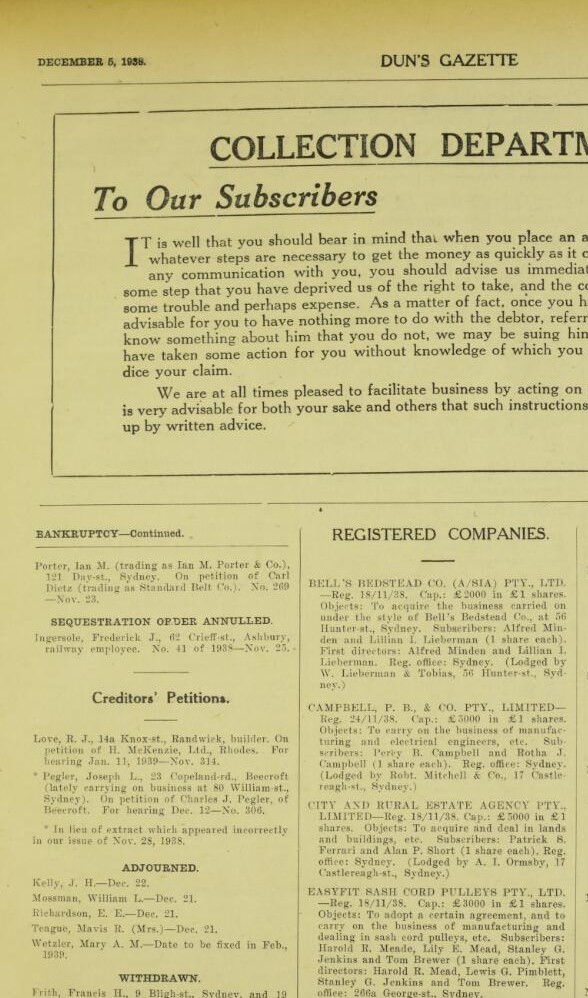
In 1940 another of his inventions is unveiled:
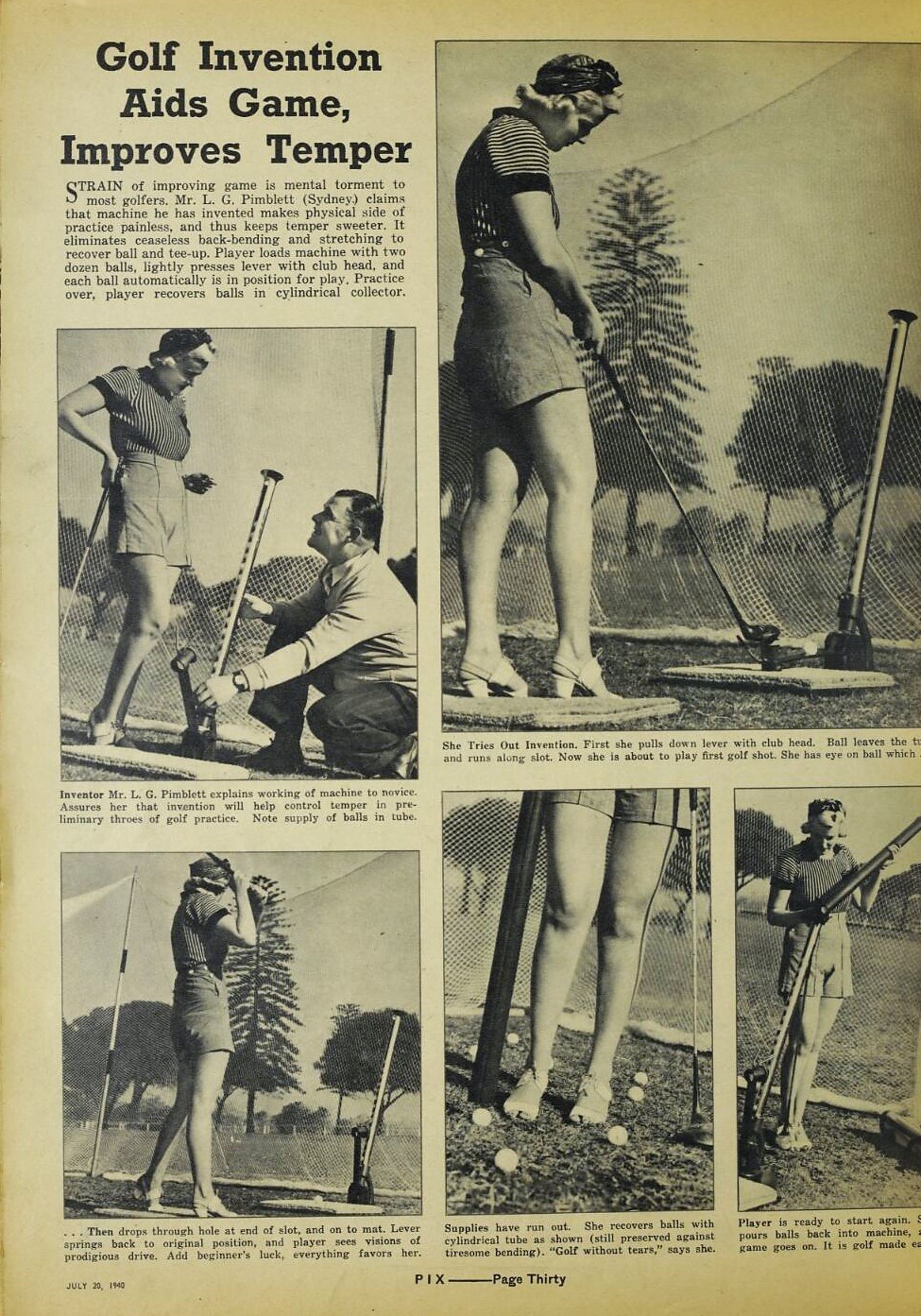
(July 1940). Golf Invention Aids Game, Improves Temper, Pix Retrieved from http://nla.gov.au/nla.obj-481909335
In 1942, like many who had professional experience, he was part of the war effort, launching the metal wood repetition company which he then onsold in 1943:


They had moved to 97 Soldiers Avenue Harbord, where he sold the musical blocks he had invented from - these were picked up by 'Butler Brothers', the New York based firm, and sold overseas as well - as shown by the use of an American 'alligator' for the letter A rather than a crocodile for C:
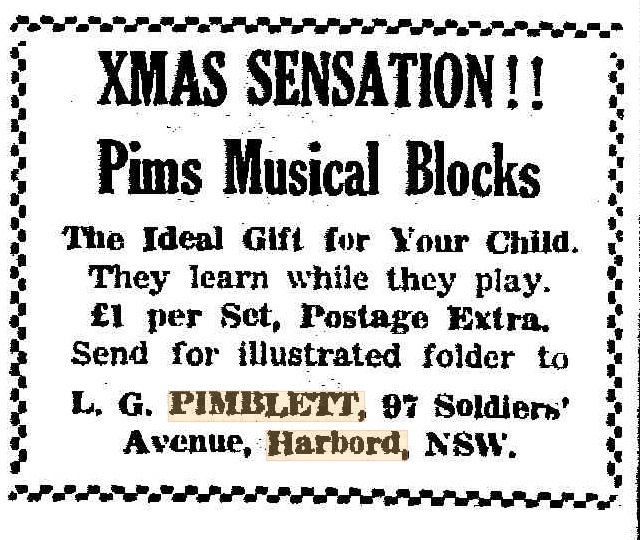
PIM’s Musical Blocks: Advertising (1945, November 23). Narromine News and Trangie Advocate (NSW : 1898 - 1955), p. 4. Retrieved from http://nla.gov.au/nla.news-article135722197
These had a Department of Wars Organisation of Industry Permit number stamped on the box as well; an Australian government office that controlled the use of strategically valuable materials for non-essential products such as toys during World War Two.
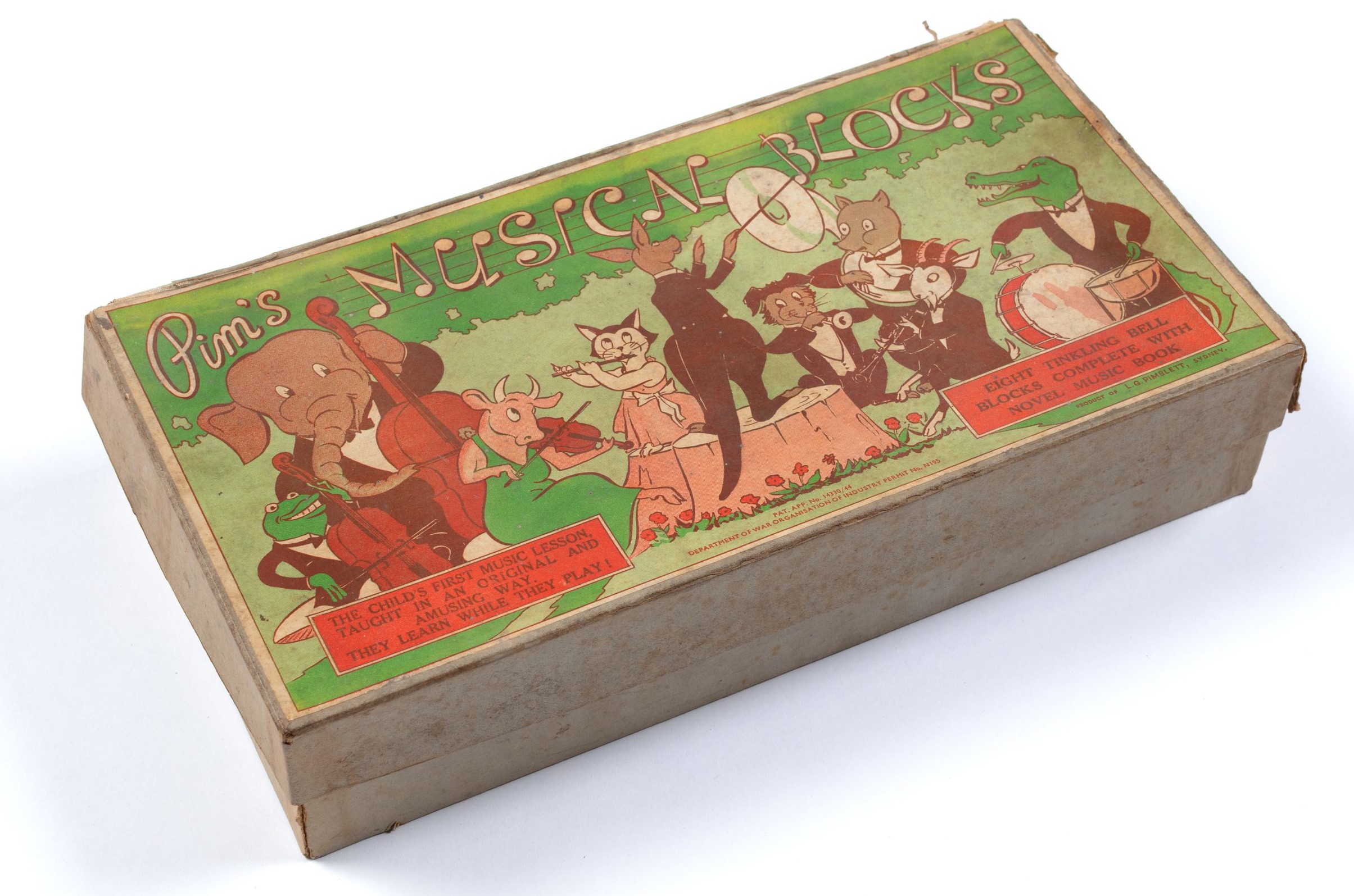
Pim's Musical Blocks' by L G Pimblett. Toy, educational, 'Pim's Musical Blocks', L.G. Pimblett, Australia, 1940-1948. Leaflet for 'Pim's Musical Blocks' educational toy, Museum of Applied Arts & Sciences, retrieved from https://ma.as/94812 Images courtesy Powerhouse museum
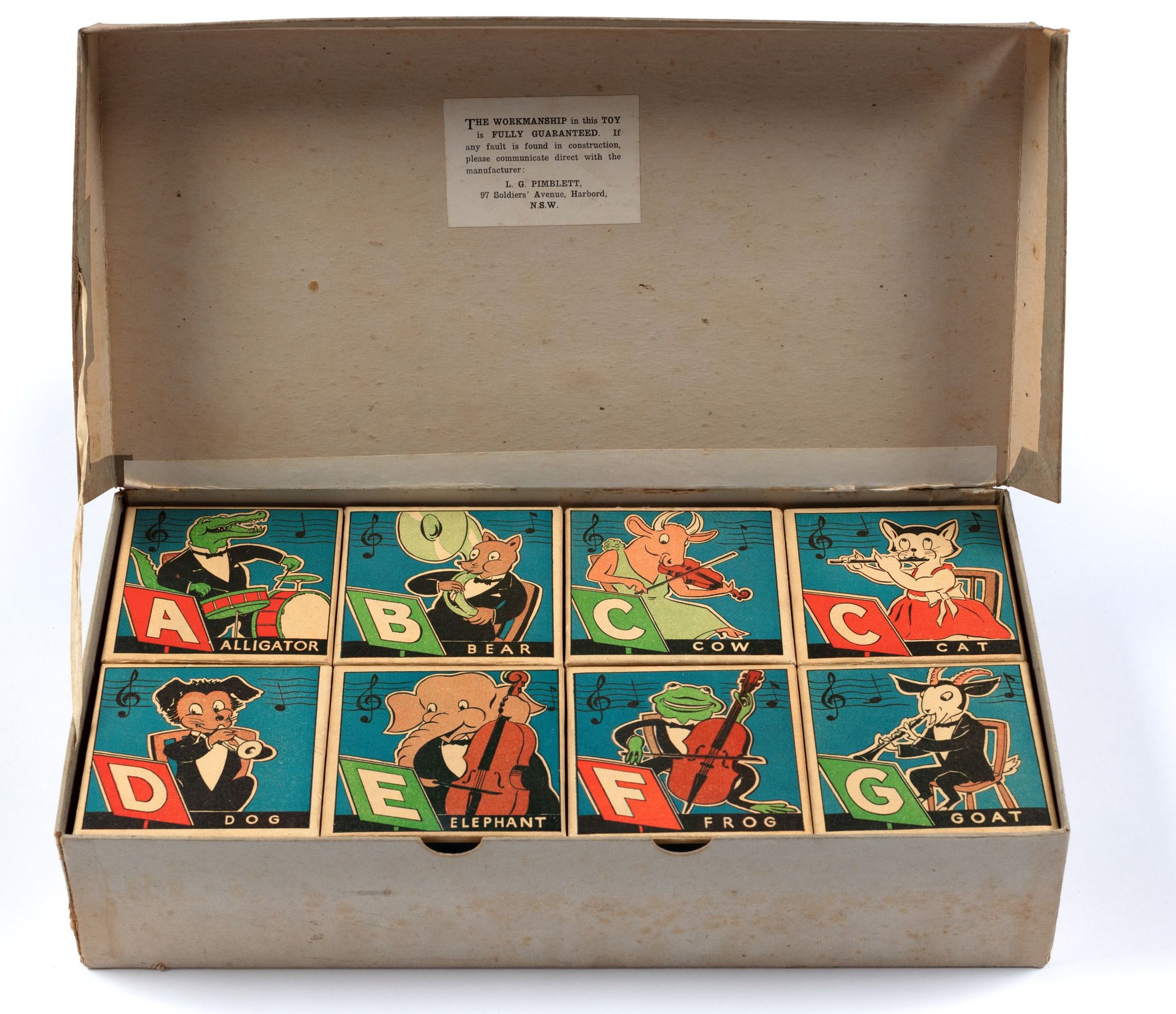
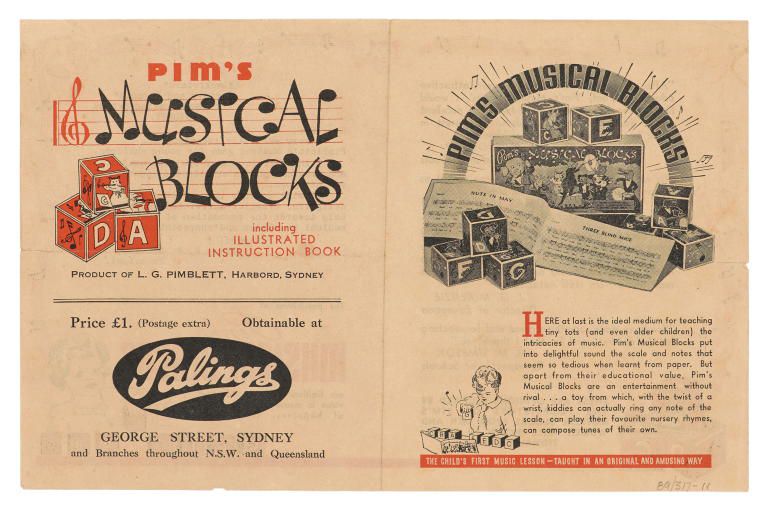
After World War Two 'Lou' as he was called by his peers, became a foundation member of the Harbord Bowling Club, showing is ongoing commitment to local community throughout his life - that organisation provides:
Early in 1946, the Harbord Club was formed when someone suggested to Tommy Judge, over a drink at the local hostelry, that a bowling Club should be formed in the district. Judge who was in the RAAF during the war, was sceptical at first, but then undertook to do his best to get the ball rolling.
On the 19 March, 1946 Tommy Judge called a meeting but only nine enthusiasts turned up. It was heart-breaking so he undertook a house-to-house canvas of the suburb in an effort to recruit members and on the 1st of June in the same year a second meeting was held with over twenty people in attendance. A committee was formed and the Club’s first president was Basil Schaaf with Tommy Judge as his hard working secretary.
A further meeting was held on the 1st of June, 1948 and Gerry Garling was elected president, with Basil Schaaf, Wal Batho, Lou Pimblett and Stan Leonard as vice-presidents.
Foundation members and 1st Board - Lewis Pimblett is gentleman standing at back - first from right
Meetings were held in the Harbord Literary Institute to test the feeling of the local people on the subject. The meetings were held on 19 March and June 1, 1946, and among others the following Resolutions were carried:
- That a Bowling Club be formed in Harbord
- That a committee of six be appointed with all the powers to take whatever steps necessary to establish this Club.
Such was the birth of the Harbord Bowling & Recreation Club (now merged into the Harbord Bowling & Recreation Club Limited.) from Foundation members of Harbord Bowling Club – from https://harbordbowlingclub.com.au/about-us/history-3/
In 1950 he and his wife Irene were behind an idea to launch a supermarket at Brookvale - this was years before the advent of Warringah Mall:
Super market for housewives on north side of harbor
A SUPER market incorporating the best ideas on the American pattern will soon be built in the Brookvale district, to provide better, fresher and cheaper foodstuffs to housewives in the suburbs north of the harbor.
Husband and wife business partners in the establishment of the market will be Mr. and Mrs. L. G. Pimblett, of Harbord.
Mr. Pimblett, who studied marketing in the United States, is getting suggestions and the practical views of local housekeepers from Mrs. Pimblett. Construction of the markets, which will cover 8000 square feet, will begin immediately, and the organisers hope to open in February; Comprehensive plans include provision for 50 or more stalls to handle general foodstuffs in a main shopping hall. The stalls will be run on a competitive basis, and, while the housewife will be able to do all her provision buying in the one hall, she should benefit from fresher supplies and lower prices.
Local vegetable gardens from Manly down to Mona Vale will send produce to the market, and local fishermen have been asked to send supplies. "It will be the first supermarket in ' Sydney and the only place where every type of foodstuff may be bought at one, centre,"' Mr. Pimblett said. It will be opened on Sundays for the sale of permitted foodstuffs and to cater for the car trade.
Architects plans show ultra-modern buildings to house stalls selling vegetables, groceries, meat, fish and poultry.
Mr. Pimblett hopes that special buses will run from Manly to Brookvale to cater for shoppers. Super market for housewives on north side of harbor (1950, September 27). The Sun (Sydney, NSW : 1910 - 1954), p. 33 (LATE FINAL EXTRA). Retrieved from http://nla.gov.au/nla.news-article230470284
Super Market for Brookvale District
A super market incorporating the latest American ideas will shortly be built in the Brookvale district. Husband and wife partners in the establishment of the market will be Mr. and Mrs. L. G. Pimblett, of Harbord. The object of the market will be to provide better, fresh and cheaper foodstuffs to housewives in the suburbs north of Sydney Harbour. Mr. Pimblett studied the latest methods of marketing in the United States, and is now gathering suggestions and practical views from residents in an endeavour to provide the best possible service. Construction of the markets, which will have an area of 8000 square feet, is to commence immediately, and the organisers hope to open in February. Comprehensive plans include provision for 50 or more stalls to handle general foodstuffs in a .main shopping hall. It is understood that the stalls will be run on a competitive basis, and thus enable the housewife to purchase fresher supplies at lower prices. Local vegetable gardens from Manly
down to Mona Vale will send produce to the super market, and local fishermen have been invited to send supplies. The market will be open on Sundays for the sale of permitted foodstuffs, and, to cater for car trade, a parking area will be allocated. Architects' plans show ultra-modern buildings to house stalls selling vegetables, groceries, meat, fish and poultry. Mr. Pimblett hopes to arrange for special buses from Manly to Brookvale to cater for shoppers.
"It will be the first super market to be established in Sydney and the only place where every type of foodstuff may be bought at one centre," Mr. Pimblett said. Super Market for Brookvale District (1950, October 4). Construction (Sydney, NSW : 1938 - 1954), p. 7. Retrieved from http://nla.gov.au/nla.news-article222890474
This item appearing in the local Hobart newspaper would be a reflection of his brothers position in that state:
At Brookvale, north of Manly, a Harbord man' and wife are going to set up a new market for local produce and fish. The markets are to cover 8,000 sq. ft., with plans for up to 50 stalls run on competitive lines. The sponsors, who are Mr. and Mrs. L. G. Pimblett, say that Mr. Pimblett studied marketing in the United States, and he is doing the right thing by getting practical suggestions through his wife from the local housewives. Sydney Topics (1950, October 4). The Mercury (Hobart, Tas. : 1860 - 1954), p. 3. Retrieved from http://nla.gov.au/nla.news-article26731514
The idea did not work and the company they formed and registered in 1951 was struck off the register prior to their move to Mona Vale, and may even have been the reason, financially, behind their move:
Brookvale Super Markets Pty. Limited. COMPANIES ACT, 1936 (SECTION 323 (5)). (1953, December 18). Government Gazette of the State of New South Wales (Sydney, NSW : 1901 - 2001), p. 4147. Retrieved from http://nla.gov.au/nla.news-article220299427
Also worth noting:
WITH radio and phonograph reproduction at a high and involved pitch of technical elaboration, Sydney inventor, Lewis Pimblett has gone back to one of the most ancient forms of noise-making for his latest idea, which he hopes will vastly improve radio, phonograph and film sound amplification. He has adapted the old hide drum skin to the new demands of full frequency reproduction, stretches the skin over a metal frame and sets the speaker behind it in an airtight compartment... The vibrations from the speaker cause the drum skin to vibrate and the results are surprisingly good. Pimblett's invention is being laboratory tested by one of Sydney's big electrical firms. ARTHUR POLKINGHORNE'S (1951, November 28). The Sun (Sydney, NSW : 1910 - 1954), p. 15 (LATE FINAL EXTRA). Retrieved from http://nla.gov.au/nla.news-article230842914
By early 1951/52 the Pimbletts are living at Mona Vale and even though Lewis has retired he is working on a new invention - this series of articles provides insights into his past and this particular invention. The series of photographs taken in July 1952 may have been taken inside that Mona vale home, where he had his workshop, and as they show the musical blocks now being sold overseas via Butler Brothers, who also had a store in Queensland from the later 1930's, and show an 'alligator' rather than a crocodile, these may have been for a press article celebrating that 'export'.
What is also interesting in these records is the partnership of sorts with 'Penneys' as these were an early form of supermarket. During the 1930s Burns Philp & Company developed a chain of some forty retail stores known as 'Penneys', and later acquired holdings in 'old established country retail businesses' including Mates Ltd and Charles Rogers & Sons Pty Ltd. These stores, with their inviting displays of goods on long counters served by one sales attendant with a cash register, or in gondolas in the aisles, introduced the idea of ‘self-service’. With the self-service supermarket and availability of branded, pre-packaged goods the grocer was gradually deprived of his role as the expert.
By 1935 there were twenty-five Penney’s stores throughout Queensland and northern New South Wales. The chain was sold to E B Coles in 1956. [4.]
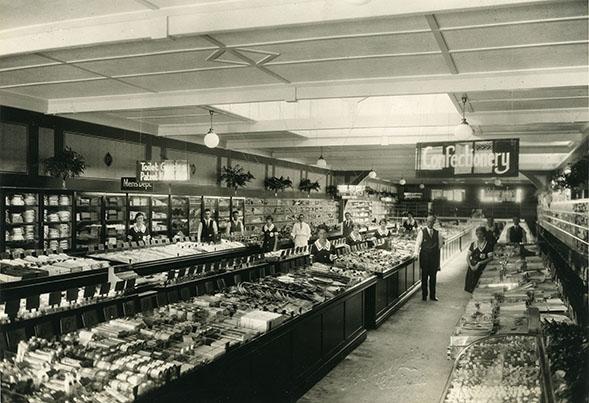
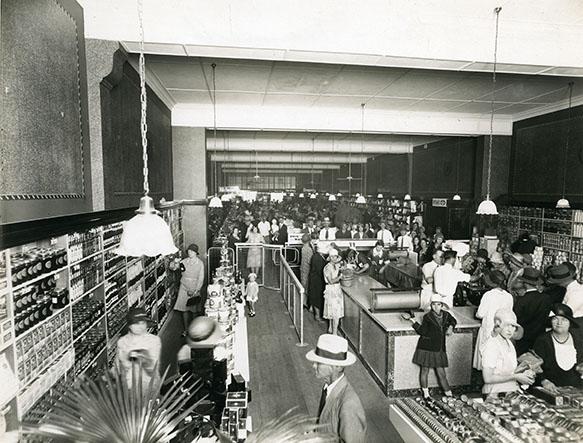
Penneys Cairns in 1930 and Penneys Townsville in 1935. Photos: ANU. Below; Penneys QLD in 1950's
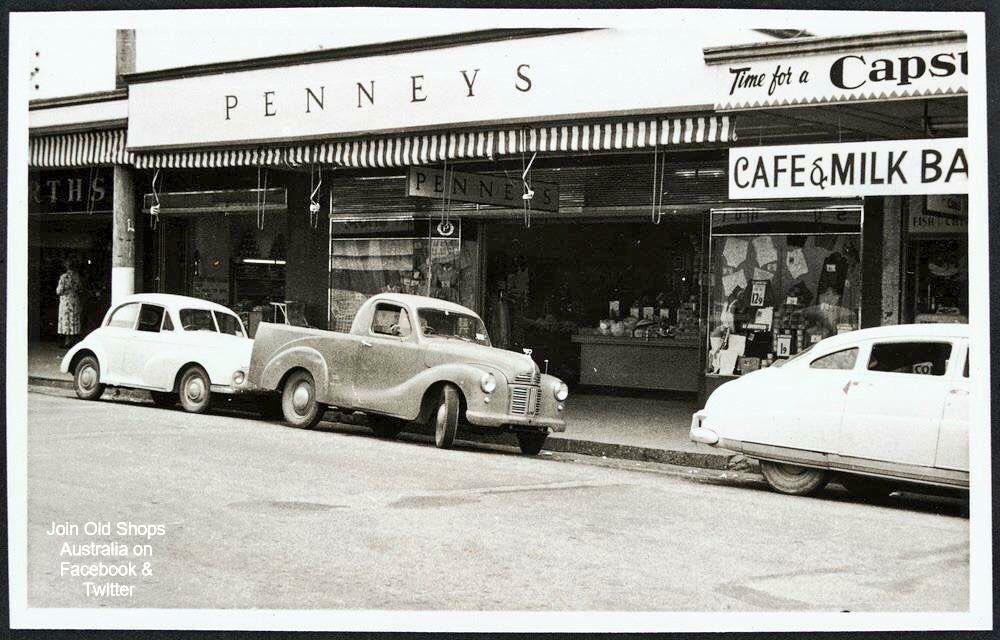
Talking Robot's First Appearance
The well-dressed gentleman who stood on a raised platform at Penneys' store yesterday and spoke with a cultured voice, moving his lips and hands and turning his head and eyes, is the invention of a retired toymaker, Mr. L. G. Pimblett, of Sydney.
Luke, the Talking Robot, is under contract to national advertisers and yesterday morning's exhibition was the first of many which will be given in every city and town between here and Albury. Clever characterisations, as well as an Irish song, are Included in the 20-minute programme, the tape recording having been produced by Ron Beck, Sydney radio artist.
The main feature of the robot, which took 12 months to complete, is the electronic movement. The perfect mouth movement is obtained from voice impulse, the lips being synchronised with the sound, and head, hand and eye movement give the robot quite a personality.
The robot is completely automatic. Connexion with the electricity supply and the turning of a switch bring the movement and voice into play, enabling the operator to leave the controls entirely.
Mr. Pimblett said yesterday that his many years of manufacturing toys had aroused his interest in a talking robot and his knowledge of electronics actually made the whole thing possible.
He was of the opinion that this talking robot was the only one of its kind in the world, as his patent attorneys had been unable to locate any other which was operated by voice impulse alone.
The mechanism is such that the turn of another switch allows a human voice speaking into a microphone to introduce local colour to the performance.
For the next three weeks, Luke, the Talking Robot, will give three demonstrations a day at Penneys' store, two each morning and one each afternoon.
UNDISMAYED BY ROBOT MAN
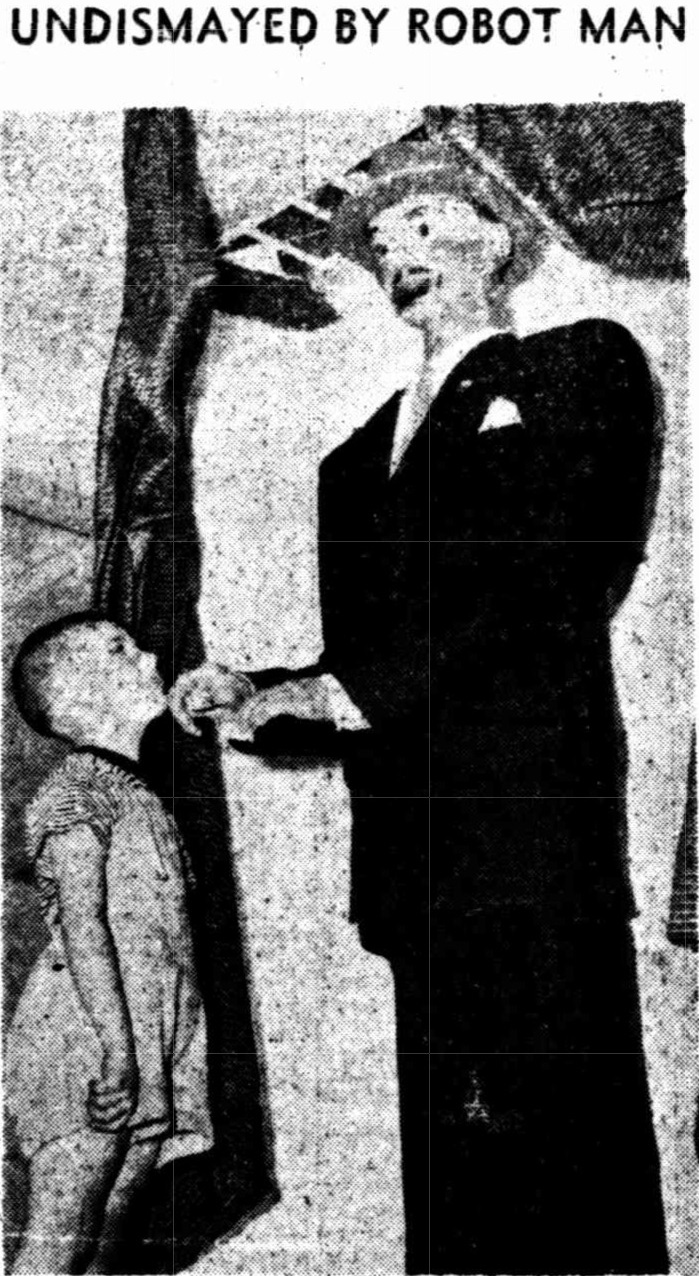
John Sampson, a seven-year-old visitor from Newcastle, N.S.W., had to look up to Luke, a life-size talking robot man, at Penney's store yesterday. Talking Robot's First Appearance (1953, September 1). Morning Bulletin (Rockhampton, Qld. : 1878 - 1954), p. 7. Retrieved from http://nla.gov.au/nla.news-article57273341
Mr Pimblett Brings Luke To Town
To many people an inventor is somewhat of a crank —a person who dribbles, mostly with alarming results, in alchemics, explosives and weird machines and liquids. Mr. Lewis George Pimblett, however, is a man far removed from the scientist or long-haired enthusiast who lives in a maze of flasks, tubing and bunsen burners. He is an inventor with a difference; his creations work, are practically designed and generally earn money. Mr. Pimblett is at present in Grafton with one of his "brain children" — Luke — a talking robot which took 12 months to build. He claims that Luke is the only genuine talking robot in the world. The robot is being used as a novel advertising medium in Penney’s Ltd.
During a 20 minute tape recorded programme, he sings, talks and gives impressions of famous people. His portrayal of Sir Winston Churchill is lifelike and natural. Luke rolls, his . eyes, moves his arms, head and lips. The movement ' of his lips "is being oiled by electronic impulses regulated by sound. His mouth moves in perfect unison.
Among Mr. Pimblett's inventions were the first car radio in Australia, an automatic turner for sheet music, a bubble pipe and soap (of which 250,000 sets were sold in Australia alone), a revolving golf tee, a set of children's blocks which give simple tunes when shaken in one of the many planned combinations, and a new system of radio sound reproduction.
Mr. Pimblett became a toymaker of national fame after the second world war. He retired recently to take up his sponsored tour with Luke. During the remainder of his tour he will visit Mainland, Cessnock, Newcastle, Wollongong, Lithgow, Bathurst, Orange, Dubbo, Young, Goulburn, Wagga and Albury. Mr Pimblett Brings Luke To Town (1954, February 6). Daily Examiner (Grafton, NSW : 1915 - 1954), p. 2. Retrieved from http://nla.gov.au/nla.news-article195512218
SCHEME TO ASSIST INVENTORS
Mr. Lewis George Pimblett, an inventor of national repute, outlined in Grafton a scheme to assist young inventors financially.
"What we need," he said, "is a free scheme in which the inventor can get Government help, in much the same manner as sick people get free medicine:' "If sponsorship' can be provided similar to that given by the War Inventions Board we could, I am sure, benefit the country by millions."
Mr. Pimblett speaks, not only with sincerity, but also with an impressive background of experience in the inventing1 field.
In 1936 he visited the United States with several inventions which proved popular. On his return he set up the agency for the Society for Visual Education. By this means he fully equipped 1200 Victorian schools with projection equipment and prepared strip films before the beginning of the Second World War.
INVENTORS' SCHOOL.
Mr. Pimblett is always impressed by juvenile deduction and inventive feats and believes that if there were an institute of invented, or a school for inventors, youngsters might be encouraged to make important contributions to the welfare and prosperity of the nation.
His plan for State-sponsored inventions is simple and brief: A committee should consider ideas submitted and recommend or reject the building of a model. Technical college workshops and drawing rooms could be used where inventors would build their own models or have them made. In return for this service (assuming the model was produced commercially and successfully) the institute (or whatever the body was called) would levy a small percentage of the royalties.
Mr. Pimblett points out that an inventor to-day has to spend nearly £50 on any sort of invention before he has legally established his patent.
"Such a cost must be faced even before the model has been built, and few young men are able to gamble with such high stakes." he added. SCHEME TO ASSIST INVENTORS (1954, February 8). Daily Examiner (Grafton, NSW : 1915 - 1954), p. 4. Retrieved from http://nla.gov.au/nla.news-article195505077
LUKE IS HERE
The answer to such cryptic messages as "Who Is Luke?" ' finally materialised today, with the appearance of "Luke, the Talking- Robot", in Penney's Armidale store. Luke Is a handsome figure, Impeccably attired, sporting a small beard and with an impressive range of imitations, patter and vocal items.
He is something new in advertising and during his 20 minute performance extols the relative merits of a number of nationally marketed products. His lip and head movements are perfectly synchronised with the sound of his voice, giving. Luke a most lifelike appearance.
Among his repertoire are excellent voice impressions of such famous personalities as Sir Winston Churchill, Barry Fitzgerald and Edward G. Robinson.
He also sings in a most pleasant manner.
INSURED FOR £500
Luke is the brain child of Mr. L. G. Pimblett, a retired toymaker of Mona Vale, who, with his wife, is on tour of all major towns from Rockhampton to Albury. The Armidale branch is the 15th Penney's store visited by Mr. Pimblett and Luke during the present tour.
Mr. Pimblett told the Express today that at the end of this tour he would consider taking Luke to Victoria. He said the robot was insured for £500 and was transported from town to town in the back of a station waggon. When asked how much Luke was worth, Mr. Pimblett said that with the robot's outstanding advertising value he would not sell it for less than £3000.
ELECTRONICALLY CONTROLLED
Mr. Pimblett said that Luke's head, hand and eye movements were electronically controlled, while the mouth action was obtained from sound impulses. The robot took 12 months to perfect. One of its most outstanding features, its mouth movement, is unique, Mr. Pimblett claims.
Luke's voice comes from a recording produced by Sydney radio producer, Ron Beck.
The straight voice is that of David Eadie, with crooning by Johnny Wade and voice impressions by prominent American impressionist, Paul Regan.
Luke is a new development in advertising and should provoke considerable interest during his five-day stay in Armidale. Family Notices (1954, February 15). The Armidale Express and New England General Advertiser (NSW : 1856 - 1861; 1863 - 1889; 1891 - 1954), p. 6. Retrieved from http://nla.gov.au/nla.news-article194338363
Robot To Disrobe.. In Public
Strong as his fascination has been for the past two weeks at Rogers, Luke, the electric robot min, will make his final appearance and disappearance to-morrow morning.
At three sessions daily Luke has been holding forth on various "red hot" bargains from Rogers' 95th anniversary celebrations, and although due to leave to-day, was "prevailed upon" to present one more session to-morrow morning at 10 a.m. Luke has made a great name for himself by identifying various customers by name as they have ventured about the store. not the least of these being the Mayor. Aid. G. E. Gerathy and the Electrical Engineer. Mr. J. Rutter. Luke requested the General Manager of Rogers, Mr. R. Thistlethwaite to invite them over for a talk. The City Electrical Engineer was greatly impressed with Luke and enjoyed his discussion with the inventor. Mr. Pimblett. Luke has kept his secret well hidden, but to-morrow morning, following his last session at 10 a.m. he will disrobe before the audience down to his last electrical impulse. It is anticipated that this final act will create considerable merriment. Robot To Disrobe In Public (1954, June 11). Goulburn Evening Post (NSW : 1940 - 1954), p. 2 (Daily and Evening). Retrieved from http://nla.gov.au/nla.news-article103691444
Luke can Talk And Impersonate
A man who considered that the average bubble-pipe of the immediate post-war era was inefficient and set about to produce an invention which was to net him, firstly £5,000 in royalties with an English promoter, and secondly money from the 250,000 sets sold in Australia, has already attracted big audiences with his latest machine, "Luke, the talking robot." He' is Lewis ("Lew") George Pimblett, a 62-year-old toy-maker who recently topped off his most unusual career by constructing, in the first year of his retirement. "Luke," which has been viewed by thousands of people in various N.S.W. and Queensland chain stores.
"Luke" was built by "Lew" in the ground floor of his modern and attractively designed Mona Vale residence and his appearances this year have more than repaid the 12 months hard work which the inventive Australian, put into his robot. Sensing his capabilities as a novel advertising medium, Mr. John Bracey first engaged "Luke" and "Lew" to appear at Lithgow some time ago and his initial faith in the robot has been justified, as this week hundreds of shoppers have taken' the opportunity to view the lifelike image.
Central West Tour
This tall, immaculately dressed papier mache model is one of the most widely travelled gentlemen in Australia and, following the conclusion of his Lithgow ' season on Friday, June 25, will move to Bathurst, Orange and Parkes. ' The feature that most impressed a "Mercury" reporter who was among the audience at one of his daily performances this .week, however, was the remarkable impersonations of famous celebrities.
These were of British Prime Minister, Sir Winston Churchill, Ronald Coleman, Barry Fitzgerald, Hugh Herbert and famous character actor, Walter Brennan.
Radio
Radio impulses operate the robot's mouth to coincide with each word he utters and, whilst stressing a point, "Luke's" hand gesticulate, his head moving from side to side. Mr. Pimblett's successes have urged him to advocate for the establishment of a Government--sponsored- Board to assist budding young inventors, whose "brain-childs," he says, could save the country millions, of pounds each year. "At the moment," he says, "inventors haven't a chance, to develop their ideas."
He backs up his point by referring to the war years, when hundreds of exceedingly useful ideas were provided toy inventors to the War Inventions Board. ' "Luke" Can Talk And Impersonate (1954, June 18). Lithgow Mercury (NSW : 1898 - 1954), p. 6. Retrieved from http://nla.gov.au/nla.news-article220817277
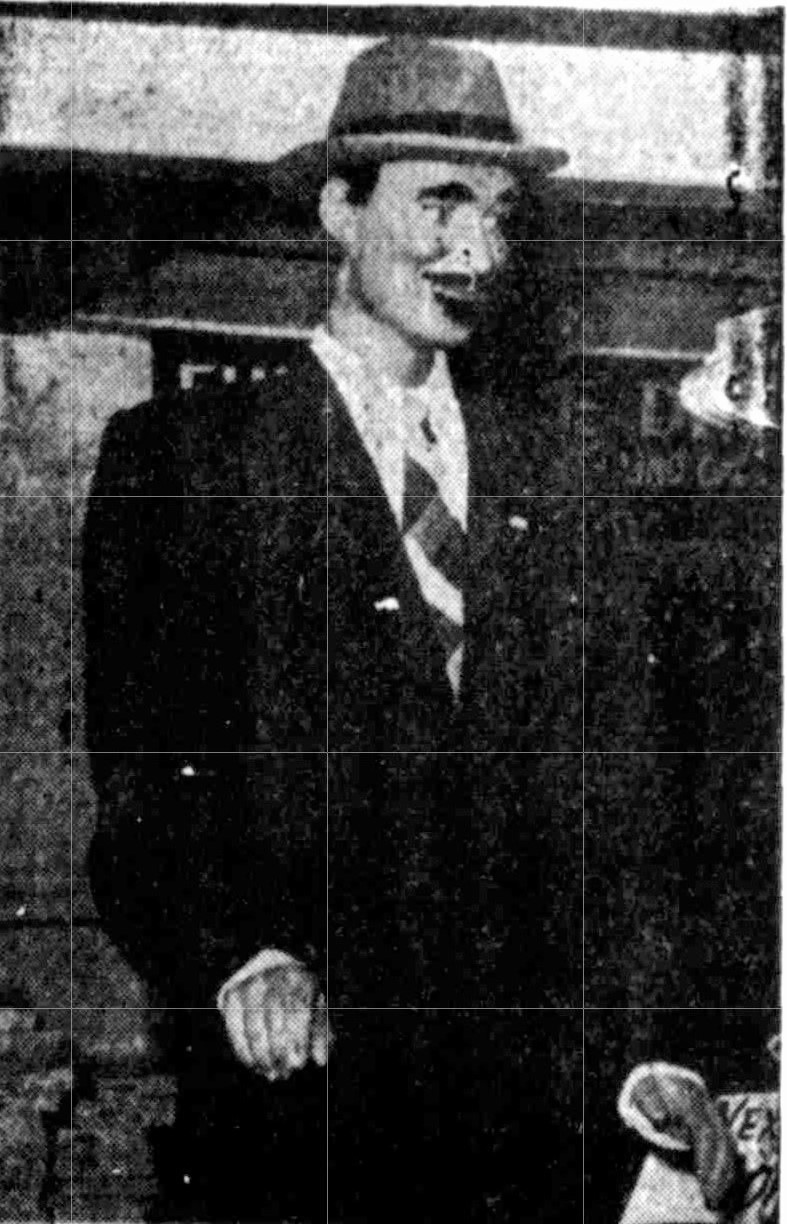
Introducing Mr. L. G. Pimblett's talking robot, which-intrigued kiddies (and grown-up kiddies) at its first appearance at Edmondson's yesterday. No title (1954, August 17). Daily Advertiser (Wagga Wagga, NSW : 1911 - 1954), p. 3. Retrieved from http://nla.gov.au/nla.news-article145687655
LUKE THE TALKING ROBOT
Western Stores Feature
'Luke the talking Robot', claimed to be one of the greatest advertising mediums in the world, is at present featured in a Bathurst Store. v Luke is the brain child of Mr. L. G. Pimblett, a retired toymaker, who with his wife is on a tour of the main provincial towns between Rockhampton (Qld.) and the Victorian border.
At the present time Luke is providing entertainment for dozens of children and adults at The Western Stores In William Street.,
Luke is something apart from the usual run of puppets talking dolls and the like. His mouth movements are controlled by voice Impulses. He is well-dressed and singularly lifelike.
Made from a dummy model that is operated by a tape recorder, Luke started his career about 18 months ago when Mr. Pimblett completed him after 12 months of experiments and hard work.
Mr. Pimblett has him singing, advertising various articles, Impersonating famous characters, or Just chatting with his audience.
Luke received his name due to his resemblance to the Biblical character.
Mr. Pimblett said Luke was not the first successful invention Mr. Pimblett made. He is well-known throughout America and Australia for his unusual toys, a device to automatically turn sheet music over, and a golf tee which cannot be lost. He was the first man in Australia to operate a car radio. It consisted of a complex network of aerials and was constructed In the 1920's.
Mr. Pimblett first launched on his career at the age of 20, When he began Inventing In his father's coachbuilding workshop In Victoria. Later he founded the Victorian Patents Company and encouraged young Inventors to contact him with their ideas. Today he advocates a free invention scheme in which, promising young inventors could get Government assistance for their work. Luke will be at The Western Stores until next Friday. LUKE THE TALKING ROBOT (1954, July 2). National Advocate (Bathurst, NSW : 1889 - 1954), p. 8. Retrieved from http://nla.gov.au/nla.news-article161529391
Mr. Pimblett, of Rockhampton, Queensland, was in Yerong Creek for a short while on Saturday, and was impressed by the progress made in the township. Mr. Pimblett was in Yerong Creek about 44 years ago, and was a prominent cyclist. He is now connected with the Burns Phillip chain stores. Yerong Creek (1954, September 17). The Observer (Henty, NSW : 1950 - 1954), p. 3. Retrieved from http://nla.gov.au/nla.news-article176511693
Soon after a quick trip home it becomes apparent this 'retiree' has other plans a little further north of Pittwater:
Luxury motel near the Pool is proposed
A Sydney businessman proposes to build a modern luxury motel near Gosford Olympic Pool. The businessman, Mr L. G. Pimblett. of Mona Vale, told council on Wednesday that the motel would provide overnight accommodation for about 30 people. Shire president. Cr J. A. Brown, said that the motel would be built on American lines. He said the site would be somewhere in Mason's Parade near Gosford Olympic pool. Council decided to grant Mr Pimblett a permit providing that the building complied with council's requirements. Luxury motel near the Pool is proposed (1954, November 26). The Gosford Times and Wyong District Advocate (NSW : 1906 - 1954), p. 1. Retrieved from http://nla.gov.au/nla.news-article162871454
The Gosford Olympic pool, at 42 Masons parade Gosford, was built in 1954 and opened in 1955.
The Luke the talking robot tour continued, although this time within travelling distance of their Mona Vale home:
"Luke", Sensational Talking Robot
TO VISIT PENRITH
At Woolworths, Penrith, next Monday, January 17, Danny Shaw, popular American entertainer, will introduce the amazing talking robot, "Luke", in a series of free shows. Penrith residents should not miss the opportunity of seeing and hearing this truly amazing "Wonder Man".
Nothing like "Luke" has ever been seen before. He is claimed to be the only male "talking" robot with such a close imitation to the human body in appearance, mouth, and limb movements. "Luke's" approximation to a human being is a matter of pride to his inventor, Mr. L. G. Pimblet, a retired toy manufacturer of Mona Vale, who tells of an amusing incident that took place when he. and "Luke" were travelling recently. When boarding a train a railway porter commented, "He's too big to check through, he'll need a ticket". "But this is a dummy, not a living passenger," said Mr. Pimblet. "We carry a lot of passengers who aren't living any longer," said the porter, "but they pay full fare. You can leave him in his box, pretend it's a coffin and he'll ride in the baggage car. Or we'll make down a berth and he can travel with you. Either way, though, he needs a ticket."
There was something to be said for the railway porter. He was confronted with something new. He was looking at as close an imitation of the living body as you'll ever see, an imitation achieved by the combined skill of engineering and anatomy to produce no mere doll but the first synthetic man.
He captivates audiences with his roving eyes, his pleasant smile. He mimics famous film stars and other personalities, he sings, he's the greatest entertainment ever. "Luke", Sensational Talking Robot (1955, January 13). Nepean Times (Penrith, NSW : 1882 - 1962), p. 7. Retrieved from http://nla.gov.au/nla.news-article100987909
Much Interest-in the Robot
"LUKE" VISITS PENRITH
It is not only children who are intensely interested in "Luke", the robot, who is showing at Woolworth's Penrith store. Many adults have attended sessions put on, with Danny Shaw, popular American entertainer, taking part with "Luke". Danny was entertainer of troops in Korea.
Actually the robot has been operating for about 14 months, starting at Rockhampton (Q.), and continuing through Queensland and western towns of New South Wales down to Albury.
At those towns "Luke" was a solo entertainer. Since then Danny Shaw has come into the show and helped "Luke" in giving delight to the young people and the not-so-young.
Penrith has been favoured with the premiere in this dual entertainment. Luke (with Danny, of course) goes on to Katoomba next, thence to Lithgow, etc., appearing at Woolworth's chain stores.
Inventor of "Luke" Is Mr, L. G. Pimblet, a retired manufacturer of Mona Vale.
Penrith performances started at 10 a.m. on Monday and will conclude this Friday, 21st inst.' There are five sessions each day and each is distinct from the others. Much Interest in the Robot (1955, January 20). Nepean Times (Penrith, NSW : 1882 - 1962), p. 3. Retrieved from http://nla.gov.au/nla.news-article100988017
Lewis and Irene Pimblett moved to the Central Coast to fllow through on their Motel venture. They both now rest at Point Care cemetery. Mary Irene Pimblett passed away on November 28th 1962, Lewis George Pimblett on July 1st 1969.
The Notice in the Sydney Morning Herald of July 2nd shows the couple had grandchildren from all three daughters:
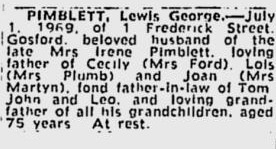
Like Harold Tristram Squire: October 28, 1868 - May 16,1938 - Artist, who was passing away in Mona Vale just as 'PIM' was arriving in our area, and who also had a penchant for inventing automatons or puppets - his being in the form of elephants, some of which you may still see on Bayview golf course as sculptures, and who was certainly a long way from his Kangaroo Flat near Bendigo beginnings and the times he was born into, Lewis George Pimblett was also certainly a long way from his beginnings in his dad's coach making business - but also a testament to what you can achieve if you have a creative or curious mind and develop an understanding of mechanics, radio or engineering.
Although it's peculiar that they both came from around the same area in Victoria and ended up in the same place in Pittwater, it may not be so to them; Mona Vale was close enough to the city during both their times of being here to make that accessible but also a peaceful green place with more than a touch of the rural or country life about it still - and would have felt like home to them both - allowed them to create.
Where you begin is not necessarily where you will stay and what you begin doing as work or as a passion will not stay the same either - it will evolve as you do.
Lewis G. Pimblett was another who wended a long and weaving path from the gold rush years and after of Victoria through the battlefields of Europe and through many a country town and back again to create some of Australia's most beloved toys and a talking robot that predates by 70 years those we see being developed today.
"All work and no play makes Jack a dull boy" - the proverb that means without time off from work, a person becomes both bored and boring, also goes to prove in 'Pim's' case that in play there is good work - many things being discovered, learned, created and made.
Lewis G. Pimblett, July 1952
Photos all courtesy Mitchell Library, State Library of New South Wales
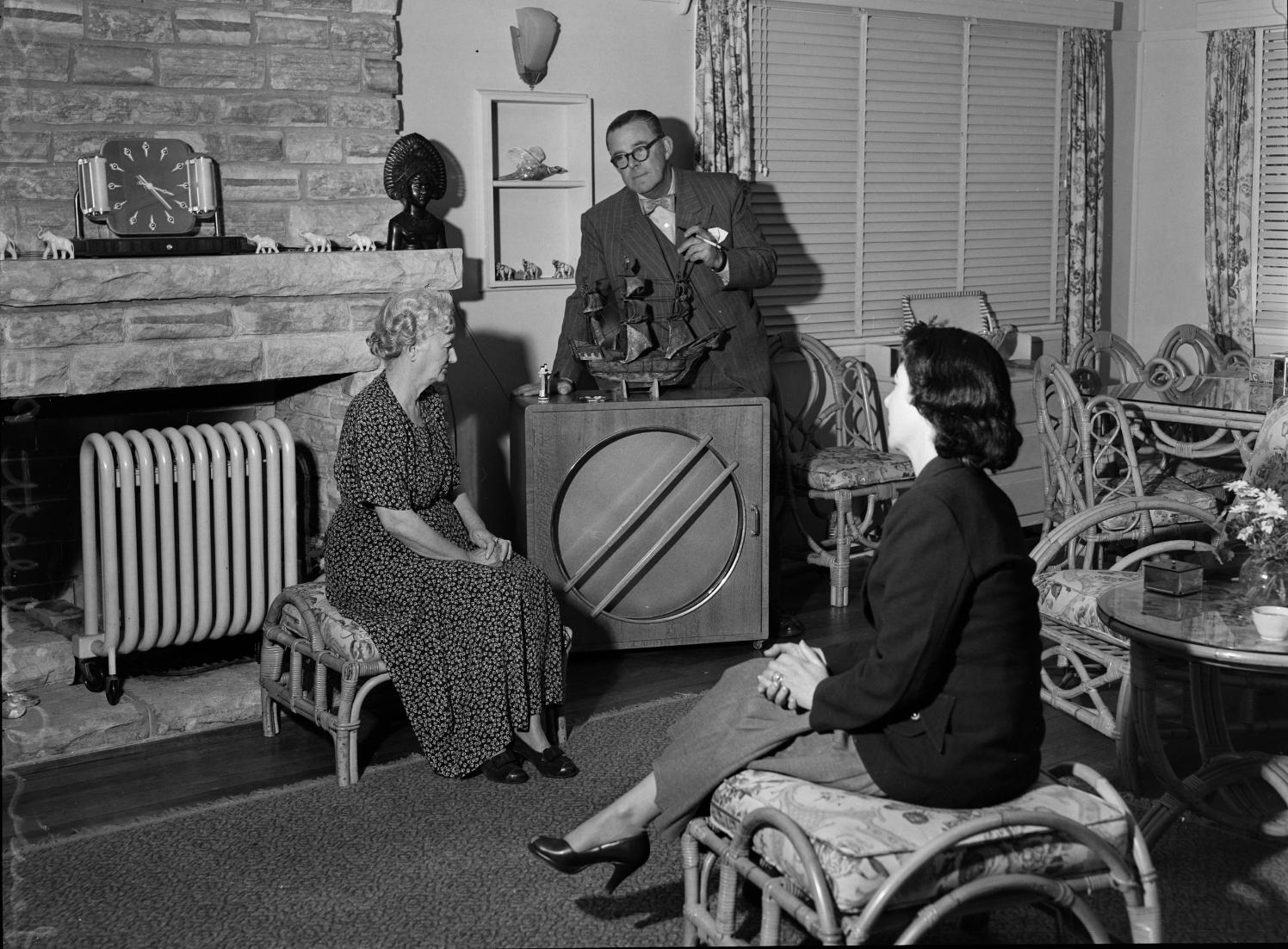
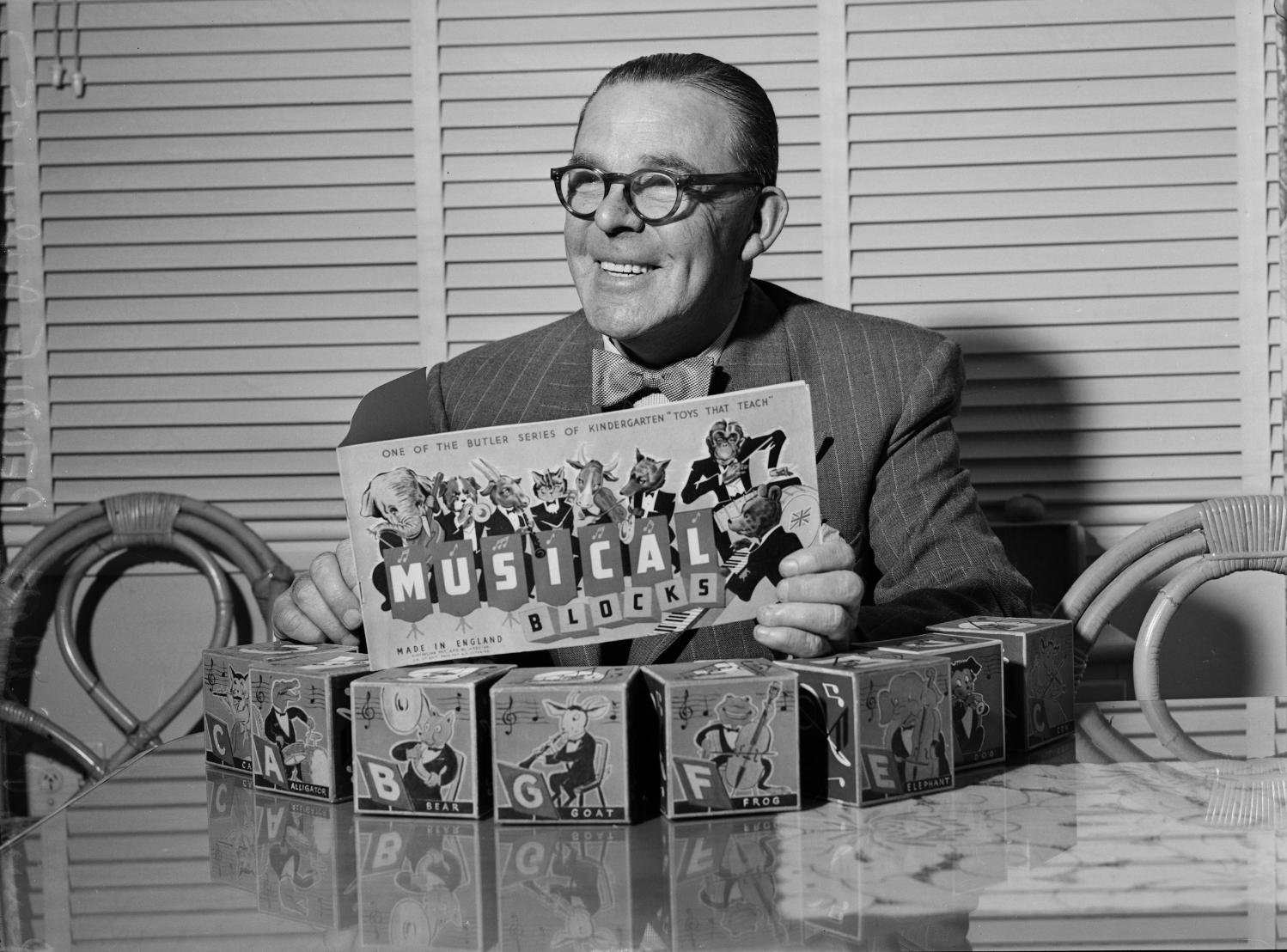
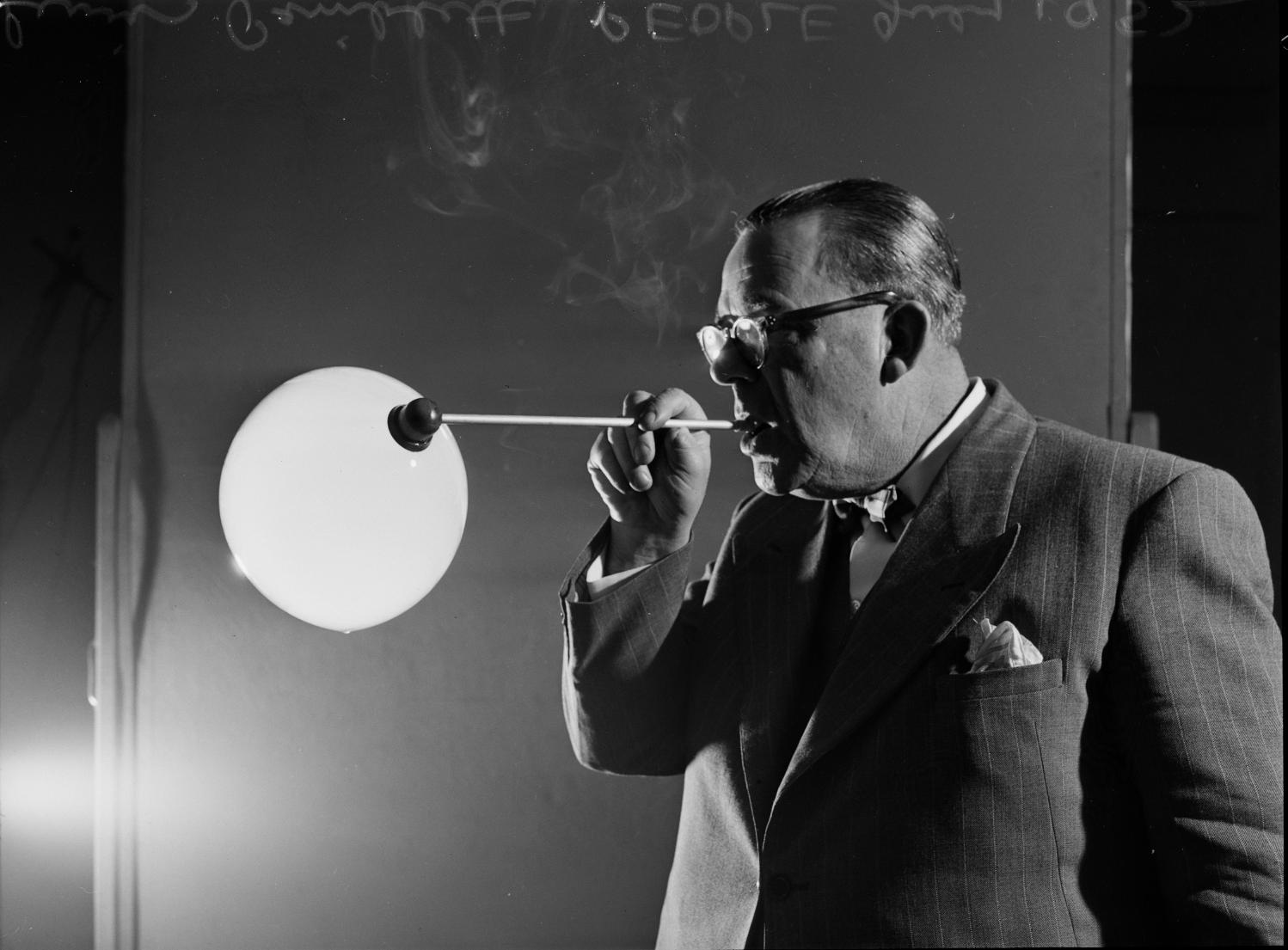
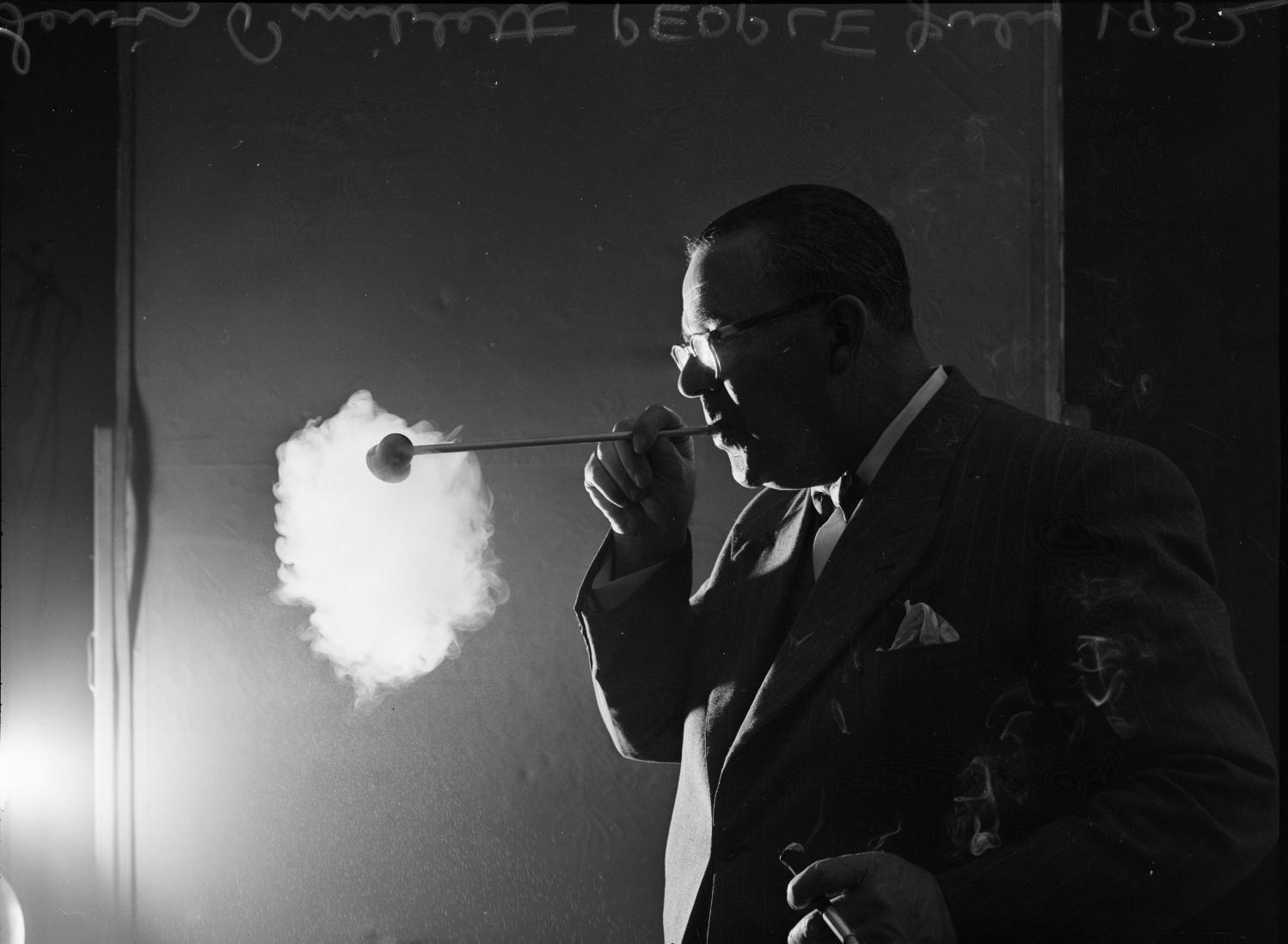
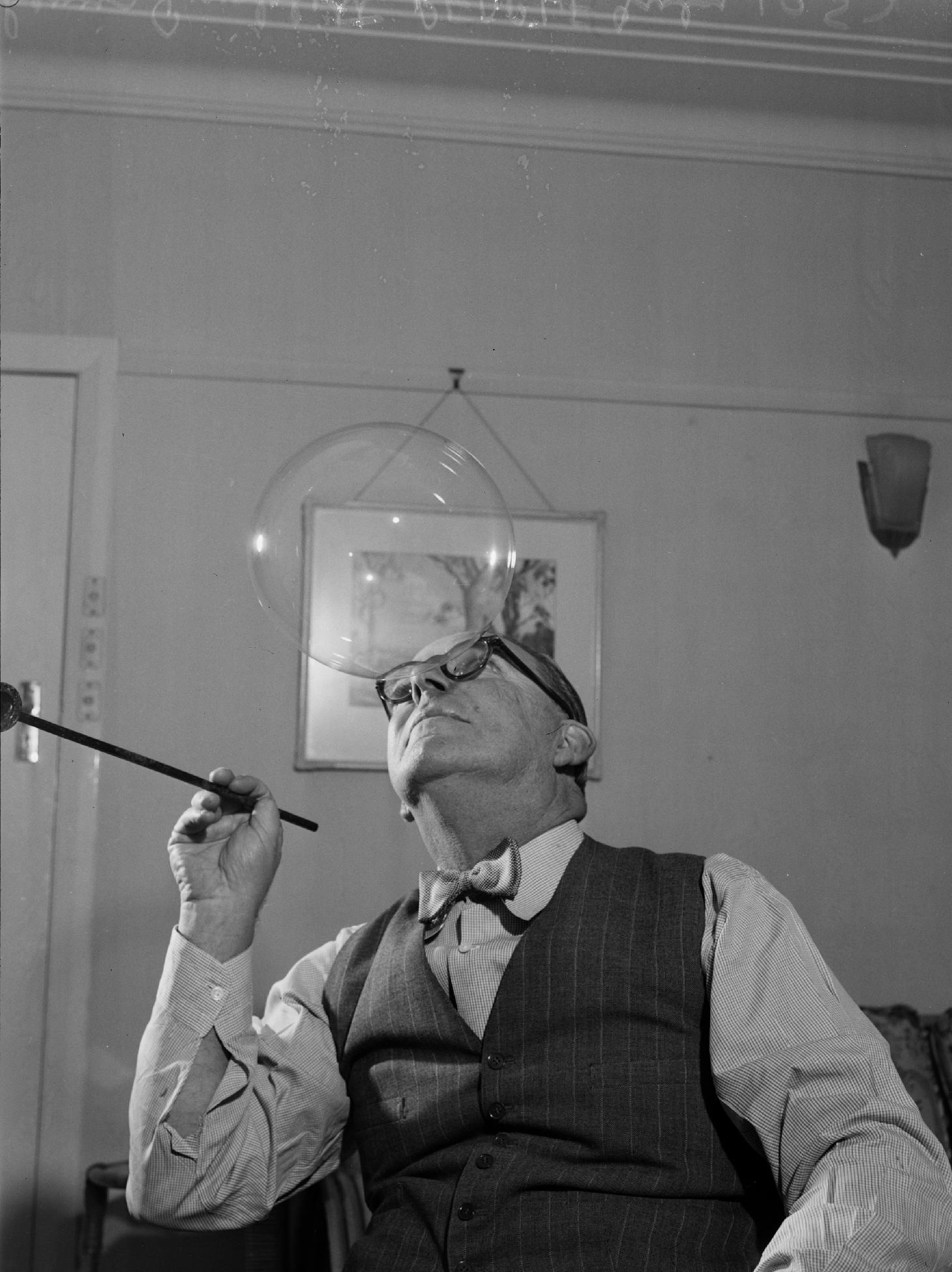
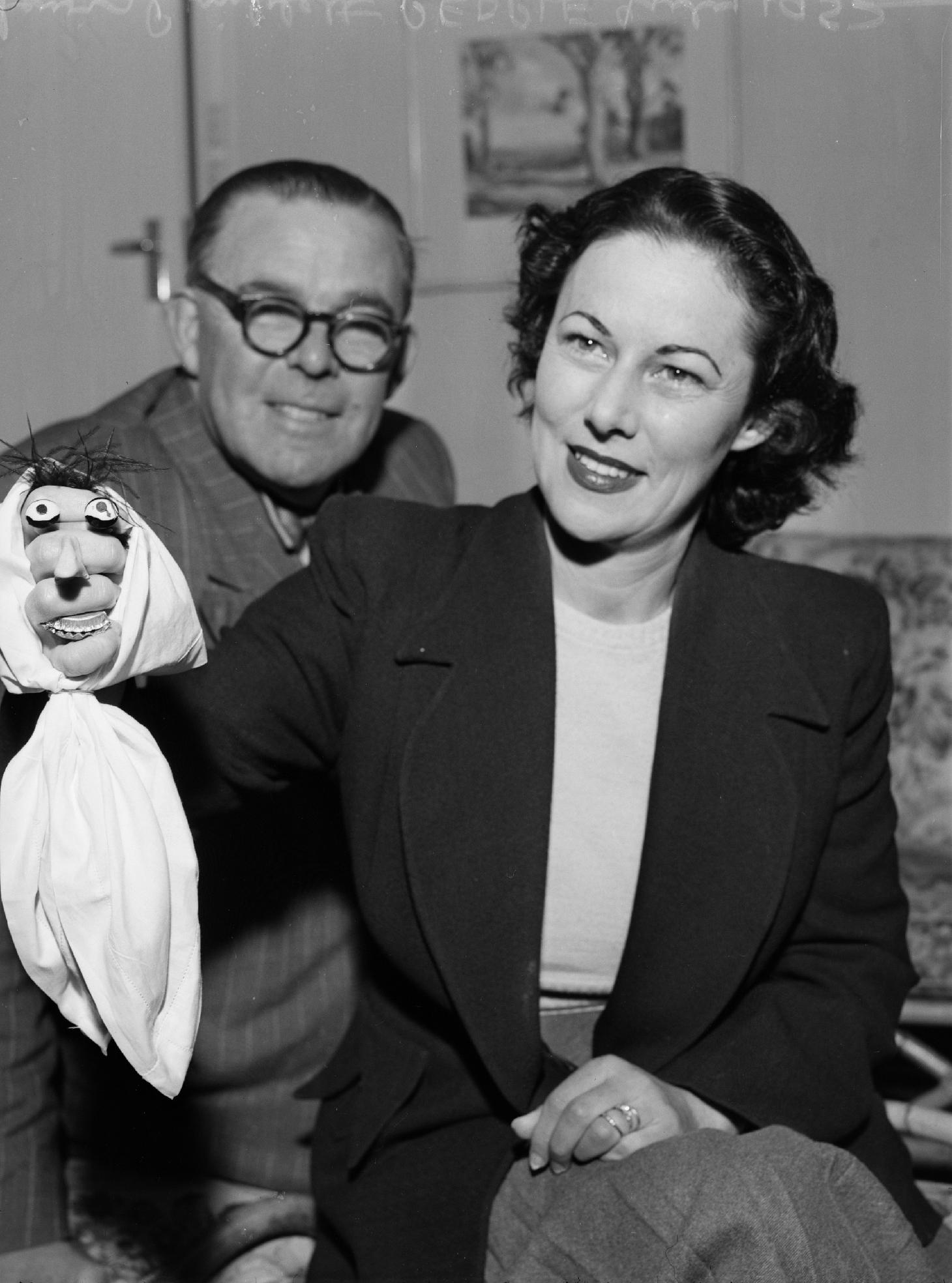
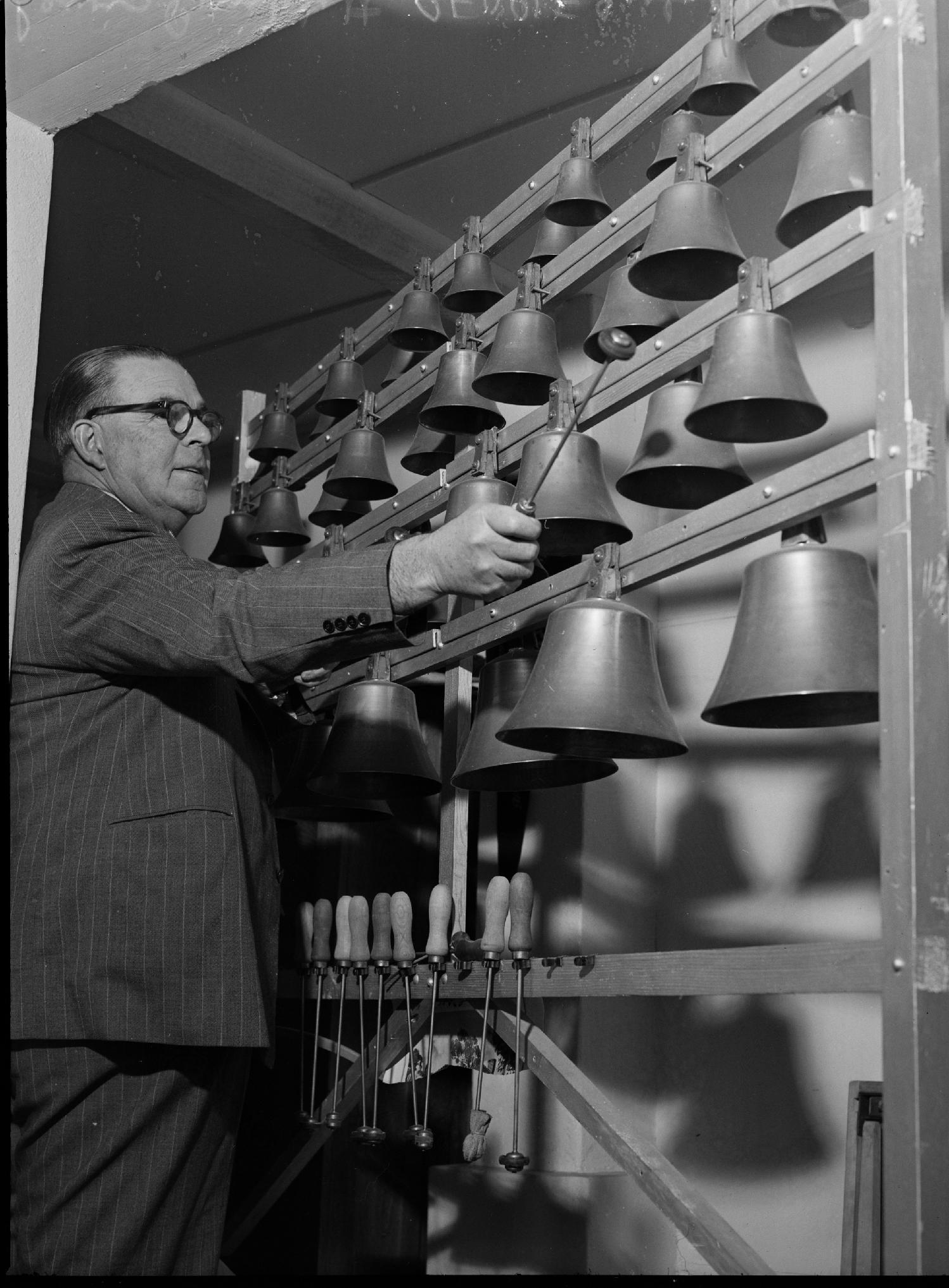
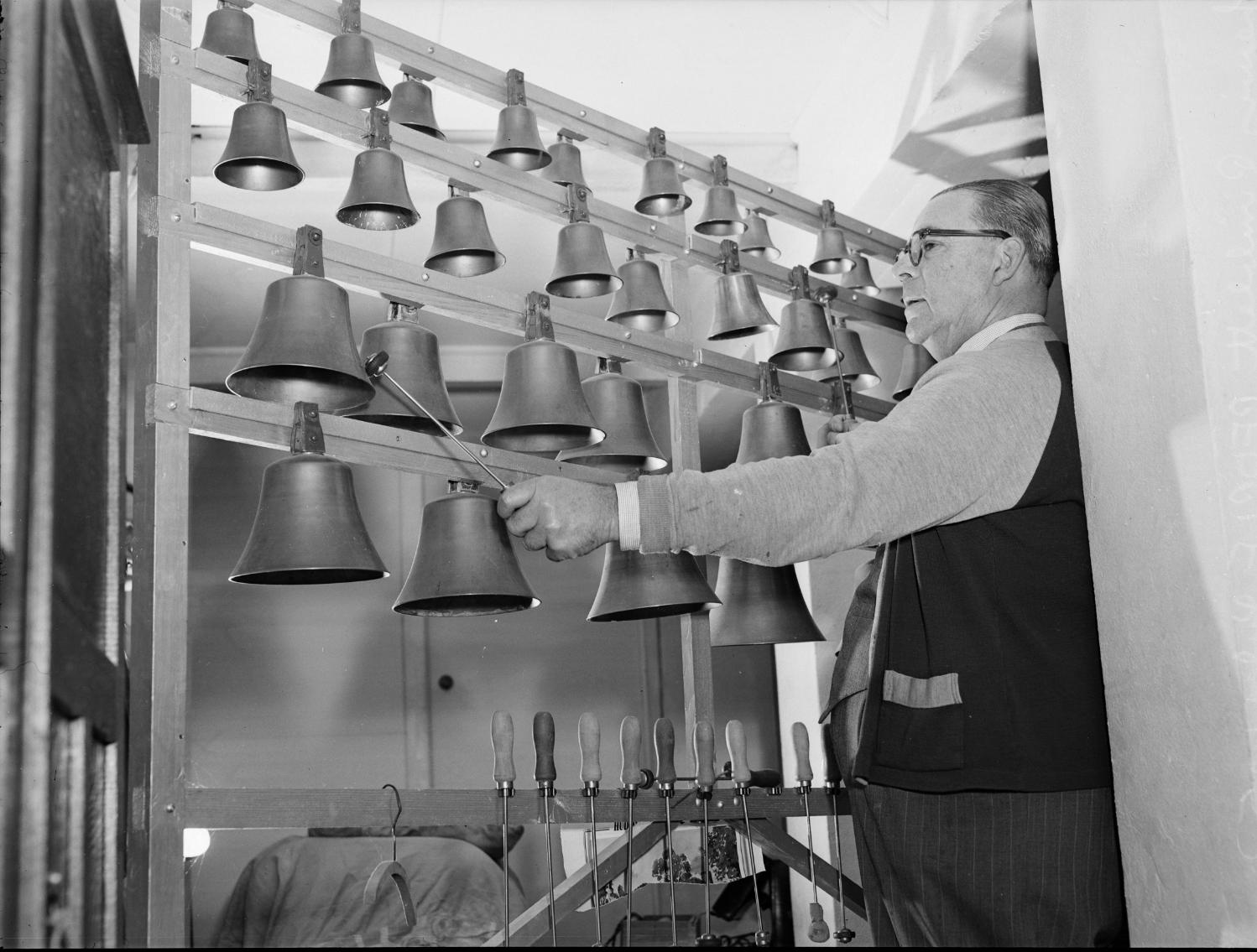
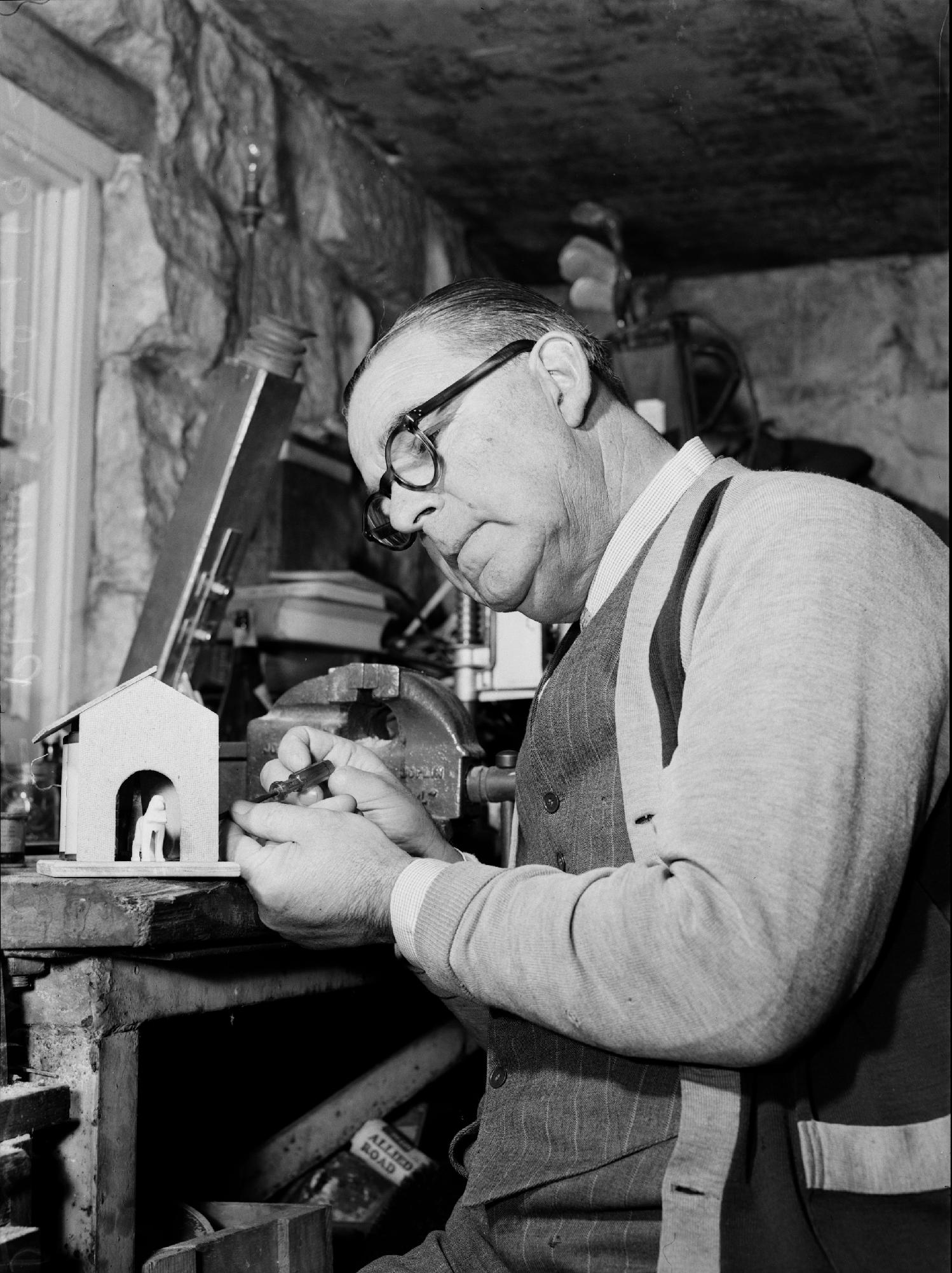
references - extras
- TROVE - National Library of Australia
- 22nd Battalion - Australian War Memorial notes.
- Foundation members of Harbord Bowling Club – from https://harbordbowlingclub.com.au/about-us/history-3/
- Penneys Limited (1931-1956). Australian National University – notes. Retrieved from: https://archives.anu.edu.au/exhibitions/high-street-dreams/chain-stores-and-self-service-supermarkets
Souvenir of the Great War [album] / Lewis G. Pimblett. Author / Creator: Pimblett, Lew, 1893-1969 - held by State Library of NSW - not digitised yet.
His grandparents and uncle:
PIMBLETT - On the 14th May. at Beaufort, Jane Pimblett, the beloved wife of William Chapman Pimblett, sen., aged 58 years. Family Notices (1890, May 20). The Age (Melbourne, Vic. : 1854 - 1954), p. 1. Retrieved from http://nla.gov.au/nla.news-article196970127
PIMBLETT.— On the 10th June, at his late residence, Beaufort, W. C. Pimblett, contractor, aged 75 years. Family Notices (1896, June 12). The Age (Melbourne, Vic. : 1854 - 1954), p. 1. Retrieved from http://nla.gov.au/nla.news-article190613030
PIMBLETT.— On the 16th October, at the Ballarat Hospital Thomas, third son of William Chapman and Jane Pimblett of Beaufort, and brother of John Pimblett, of Woodend, aged 29 years. Family Notices (1889, October 21). The Age (Melbourne, Vic. : 1854 - 1954), p. 1. Retrieved from http://nla.gov.au/nla.news-article197503469
Marriage:
10678/1914 PIMBLETT LEWIS G to TURNER MARY I PETERSHAM
Mary Irene Turner – birth:
TURNER MARY I 14363/1889 parents: ALEXANDER N and MARGARET registered at GOULBURN
Children – one born just after he left to serve in WWI, all girls
PIMBLETT CECILIE Margaret 43326/1914 LEWIS G MARY I ST PETERS
PIMBLETT LOIS Vivienne 2326/1917 LEWIS G MARY I CANTERBURY
PIMBLETT NORMA Joan Janet 18454/1920 LEWIS G MARY I CANTERBURY
Mary Irene Pimblett - Date of Death 28/11/1962, Granted on 30/09/1964
Mary Irene (Turner); 6087A, Point Clare NSW, Pbn 2 10, 18. Pimblett (Turner) · Mary Irene, 1889, 28 Nov 1962
Lewis George Pimblett. Death: 1 Jul 1969; Burial. Point Clare Cemetery. Point Clare, Central Coast
PIMBLETT Lewis George : Service Number - 6087 : Place of Birth - Beaufort VIC : Place of Enlistment - Sydney NSW : Next of Kin - (Wife) PIMBLETT Irene
AWM Records of his caricatures for the 22nd Battalion paper:
Private M. Cowan - Art. Maker: Pimblett, L - Caricature of Private M. Cowan. He has a skinny body and an exaggerated head and wears a slouch hat. ARTC00010
Regimental Sergeant Major S Caldwell - Art. Maker: Pimblett, L. This is a caricature of Regimental Sergeant Major S Caldwell. He has a skinny body and an exaggerated head and he wears a slouch hat. ARTC00013
Sergeant Wilfred Nash - Art. Maker: Pimblett, L. Caricature of Sergeant Wilfred Nash. He has a skinny body and an exaggerated head and wears a slouch hat. ARTC00014
